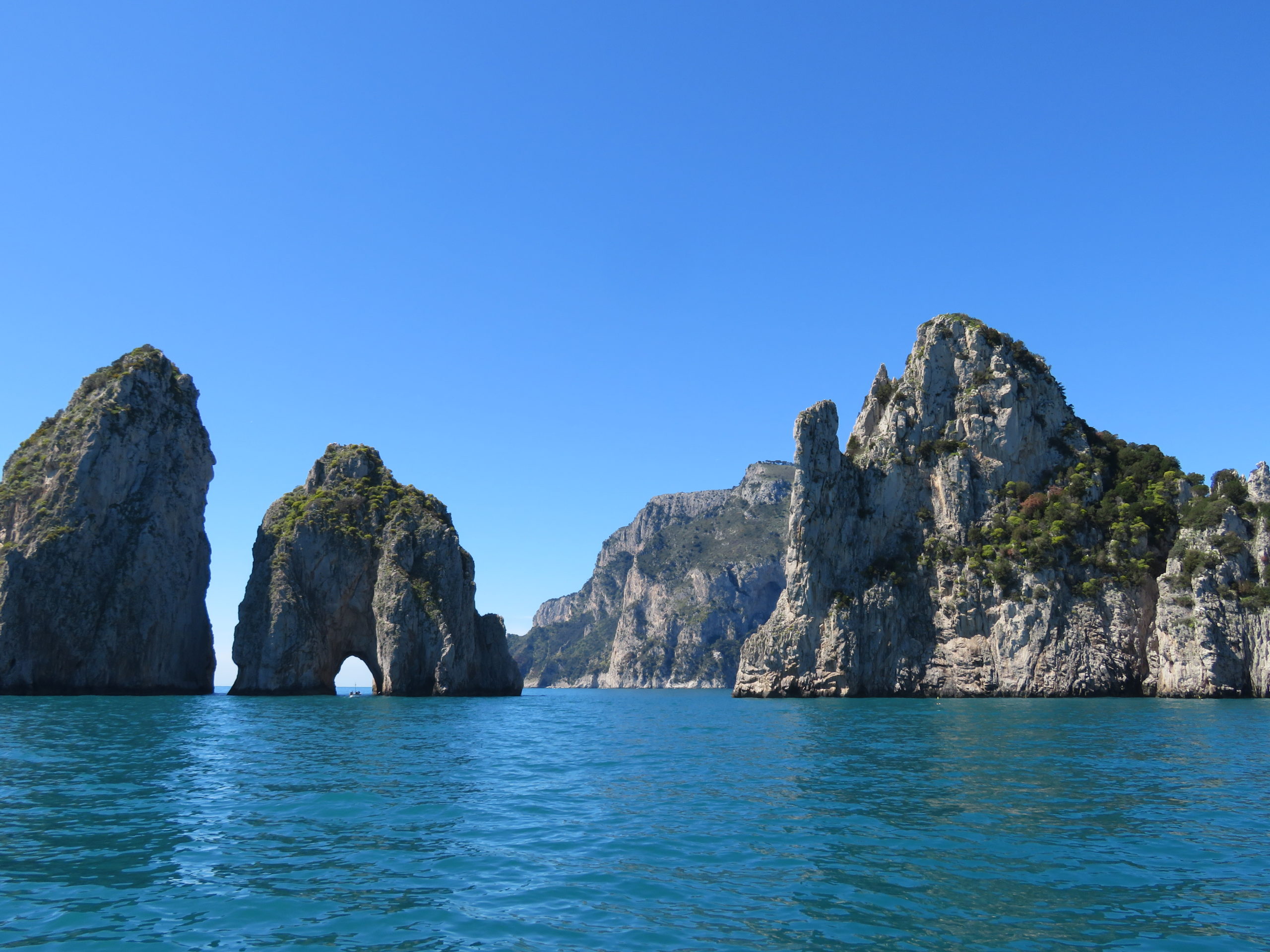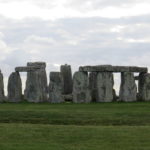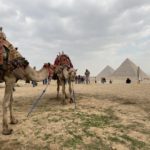In March 2018 we had a family trip to southern Italy for a week, including kids aged 5 to 14 years. This wasn’t our first time in Italy – we already visited it several times prior to this trip, including another family trip in the south several years ago.
This time we decided to focus on two areas – Apulia (or Puglia), located in the heel of the Italian Boot, and the Amalfi coast, which we already visited before but decided to return once again because it is so beautiful. Since the trip was relatively short, we spent 3 days in each area, which obviously allowed us to get a brief glimpse only of both.
Day 1
We landed at the Leonardo da Vinci International Airport in Rome at the evening, picked up the rental cars and started driving to the hotel where we spent the first night. Our intent was to save travel time in the next day and get closer to Apulia. We stopped on the way for a quick dinner at an Autogrill highway restaurant, a chain spread across Italy. We spent the night at Hotel Liola, located next to Cassino, which is about an hour and a half drive from Rome. We stayed in a 4-persons family apartment located in the annex, right next to the main hotel building. The apartment was great – well-designed and spacious. The price was 154€ per night, including breakfast.
Day 2
After breakfast we left the hotel and set off for a 4-hours’ drive east towards our first destination for the day – the town Trani which is located on the shores of the Adriatic Sea.We spent a few hours in the lovely town. We started (of course …) with an excellent Italian ice cream at an ice cream parlor called La Scimmietta.
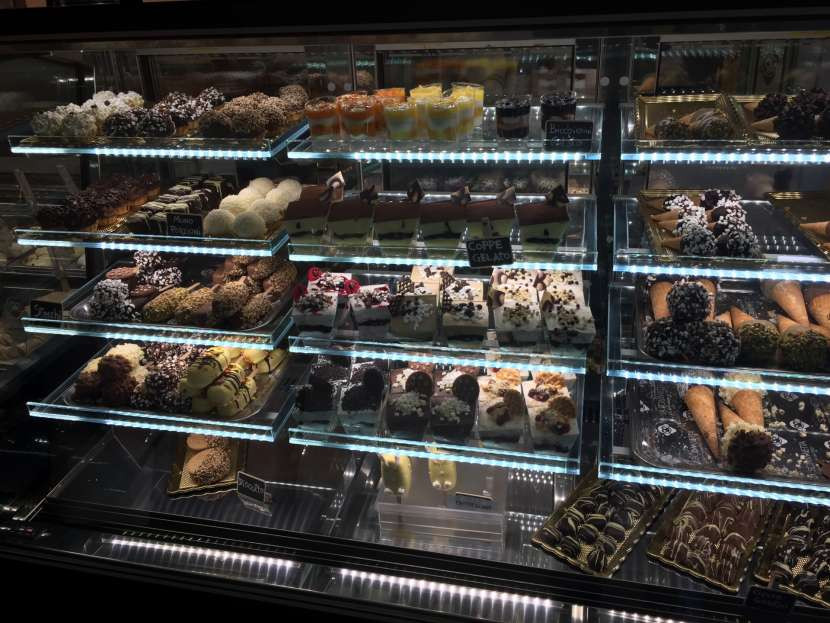
The desserts window at La Scimmietta
We then strolled through the town’s picturesque harbor and checked the variety of daily fresh fish offered by the local fishermen who had just returned from the sea – including a squid who was trying to escape the bucket in which it was kept, and several sea turtles ( we thought of buying them and releasing them back to sea…).
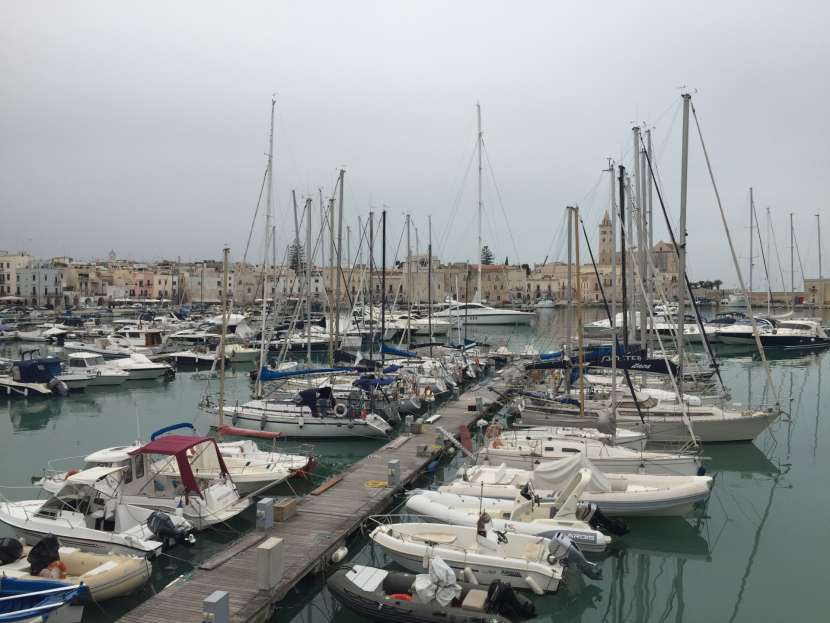
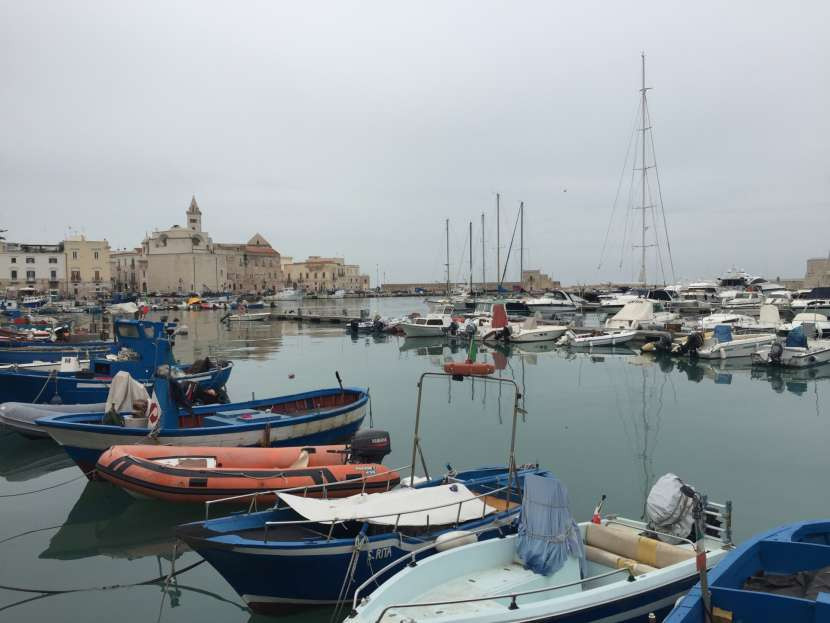
Trani harbor

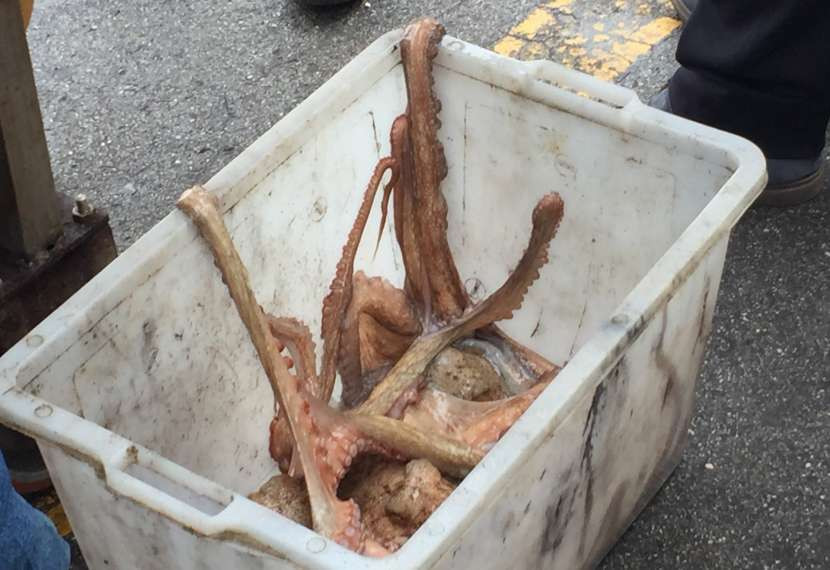

The small Trani fish market
We then visited the large and beautiful Trani cathedral, located at the other side of the harbor.
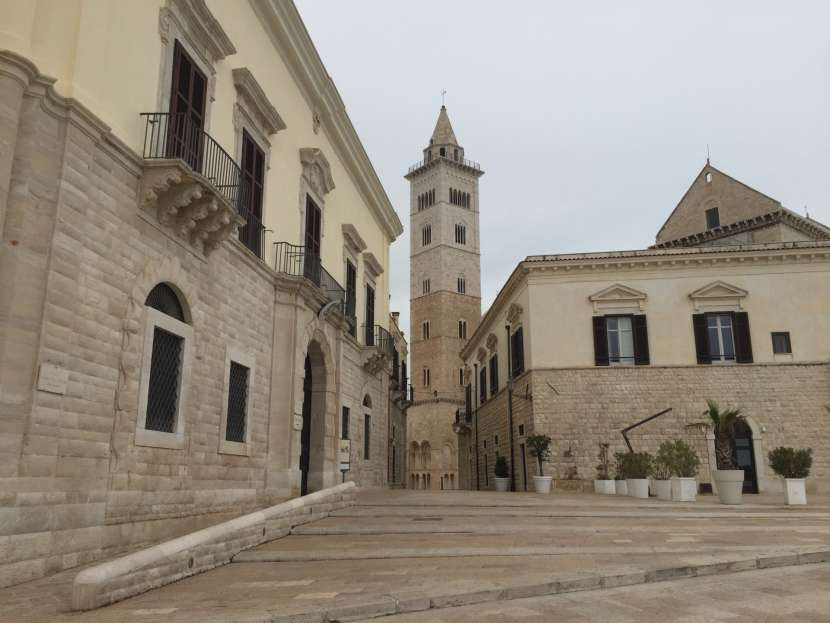
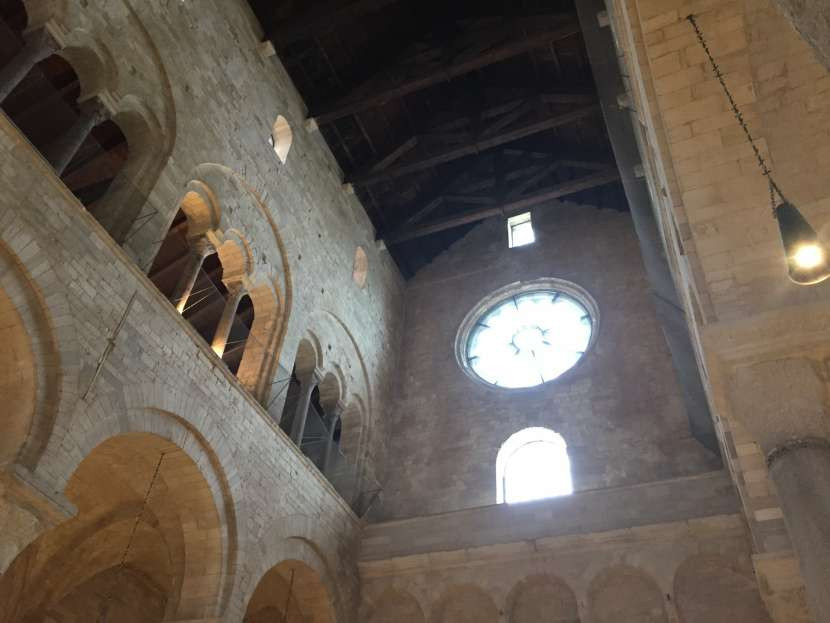
The Trani Cathedral
We also visited the nearby town museum, which hosts a beautiful archeological display and an interesting exhibition of typewriters, including an original model of the first mass-produced typewriter made by Remington in 1874.
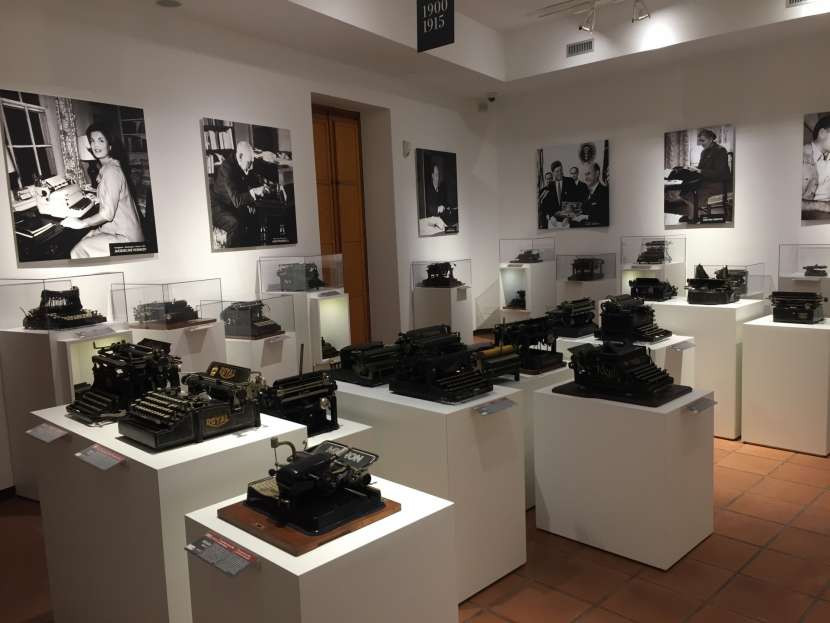
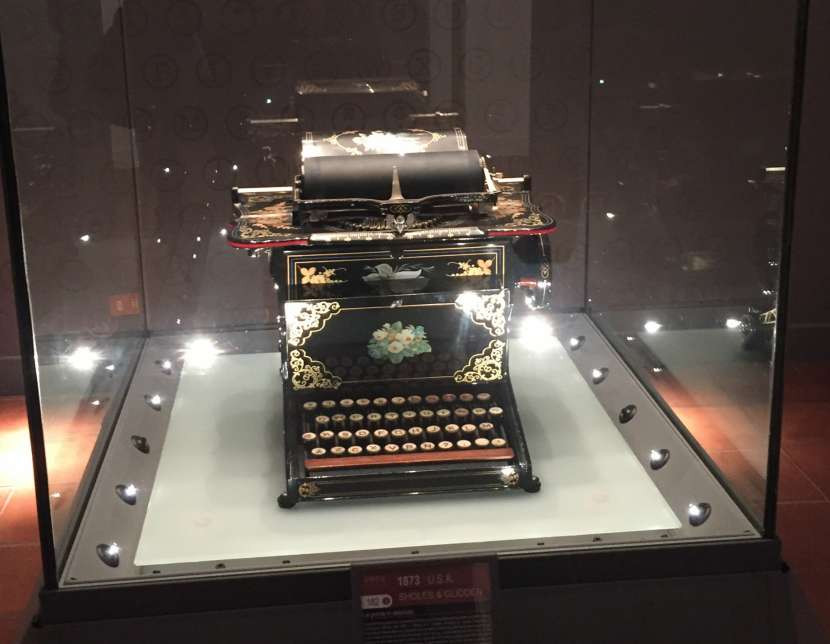
Typewriters display
We left Trani and drove to Alberobello, where we stayed for the next three days.
The most typical structure of Apulia is the Trullo – a cone-shaped hut with a pointed roof, built out of stone without the use of cement. The Trulli (in plural) can be found In various towns throughout the region. Alberobello specifically is known as the “Trulli capital of Italy” – it has many beautiful Trulli and was also declared a UNESCO world heritage site in 1996. We stayed at “Trulli San Leonardo B&B”, which is located just outside the town next to a small water park called Water Splash 2008 (open only in the summer season). We got 3 Trulli, two designed for a family and another one for a couple. The Trulli were pleasant and well-equipped, staying in them was a nice experience. The cost of a family Trulli for 4 persons was 260€ for 3 nights, including breakfast. When traveling with small kids, it should be noted the specific cabin we got had two small sleeping rooms on the second floor, which are reached by climbing a wooden staircase.
Trulli San Leonardo B&B website
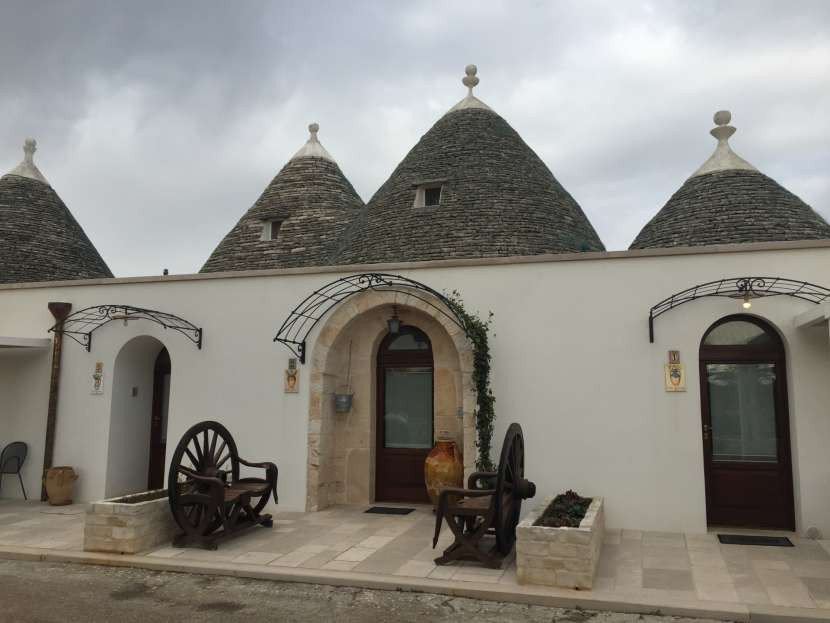
Trulli San Leonardo B&B
We had a great dinner at an Italian restaurant called La Nicchia, which is a few minutes’ drive from the B&B.
La Nicchia website (In Italian)
Day 3
After a nice breakfast, we went for a walk in Alberobello.
It was Thursday, the weekly market day. Multitude of stalls selling clothes, food and souvenirs were spread out in the main town square, at the foot of the town hall and throughout the nearby streets. The main tourist areas of town, with most of the Trulli, are Rione Montiand and Aia Piccola. We went down one of the narrow streets leading from the main square towards Via Indipendenza – a wide pedestrian street with a variety of shops, cafes and restaurants. Several steep alleys with beautiful renovated Trulli, most used as souvenir shops now, rise from the main street. We walked around, bought a few presents, had some ice cream and snacks and visited the small market at Largo Martellotta street, where farmers from the area sell their fresh goods.
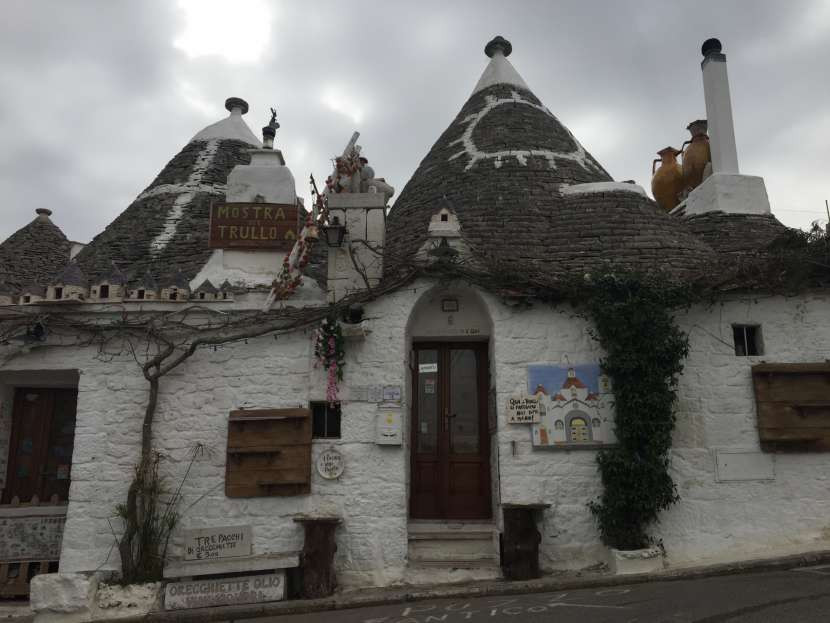
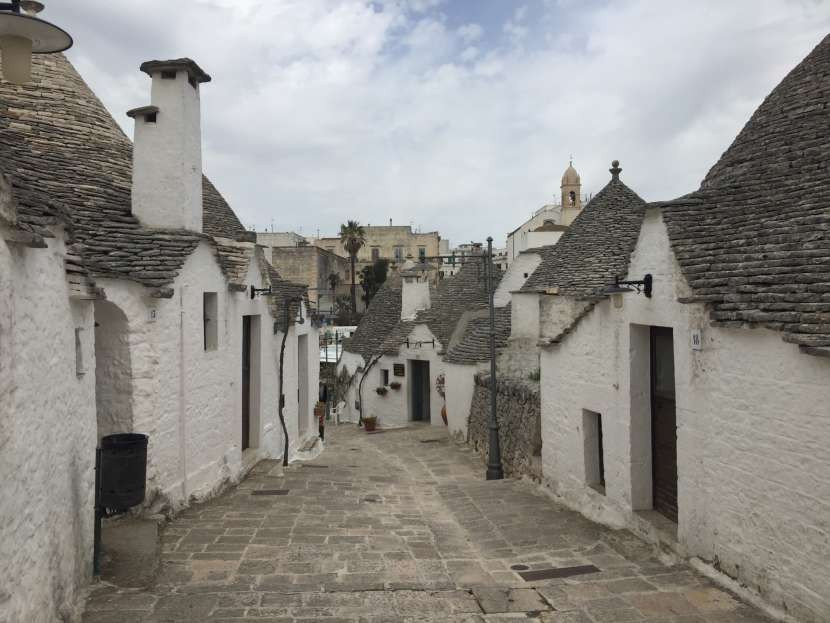
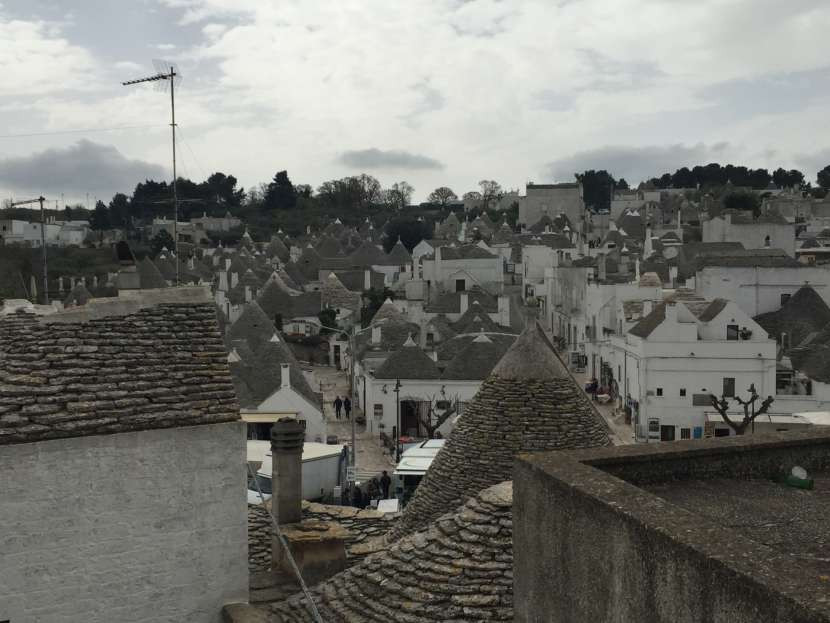
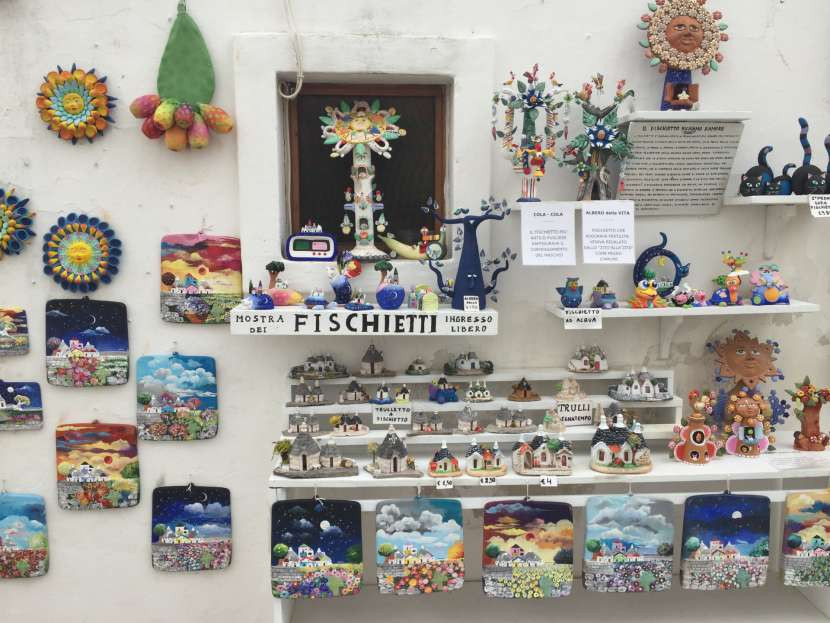
The Trulli at Alberobello
In the afternoon we set off towards our second destination for the day, Martina Franca – which is about half hour’s drive from Alborobello. When we got there, we had lunch at a great restaurant called Ristorante I Templari, located at a beautiful stone house. The meal was delicious and consisted mainly of fresh pasta dishes in various sauces, however it took some time – the Italians are in no hurry when it comes to good food 🙂
The charming Baroque town of Martina Franca is best known for its ancient historic center. We wandered through the narrow streets and alleys, the beautiful buildings and the picturesque squares for about two hours, and then continued to Polignano a Mari, about an hour’s drive away.
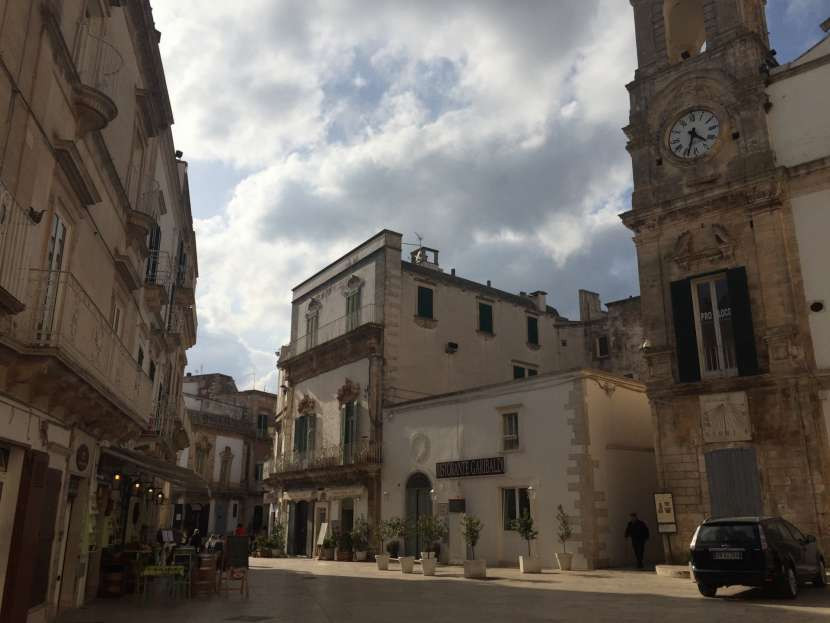
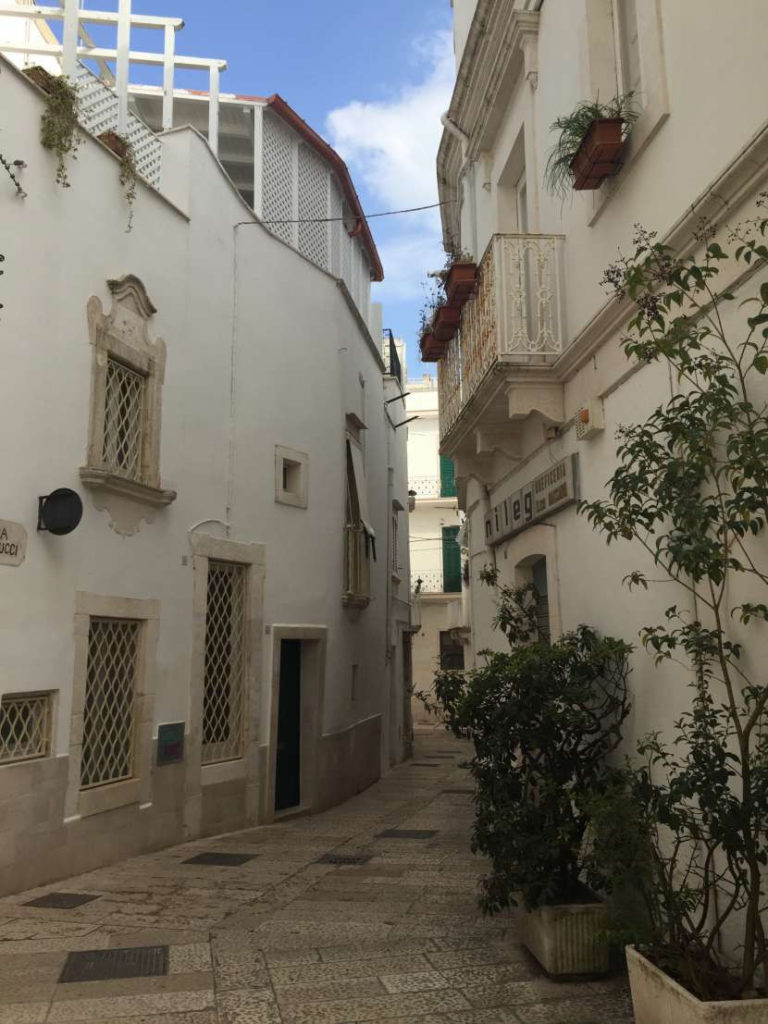
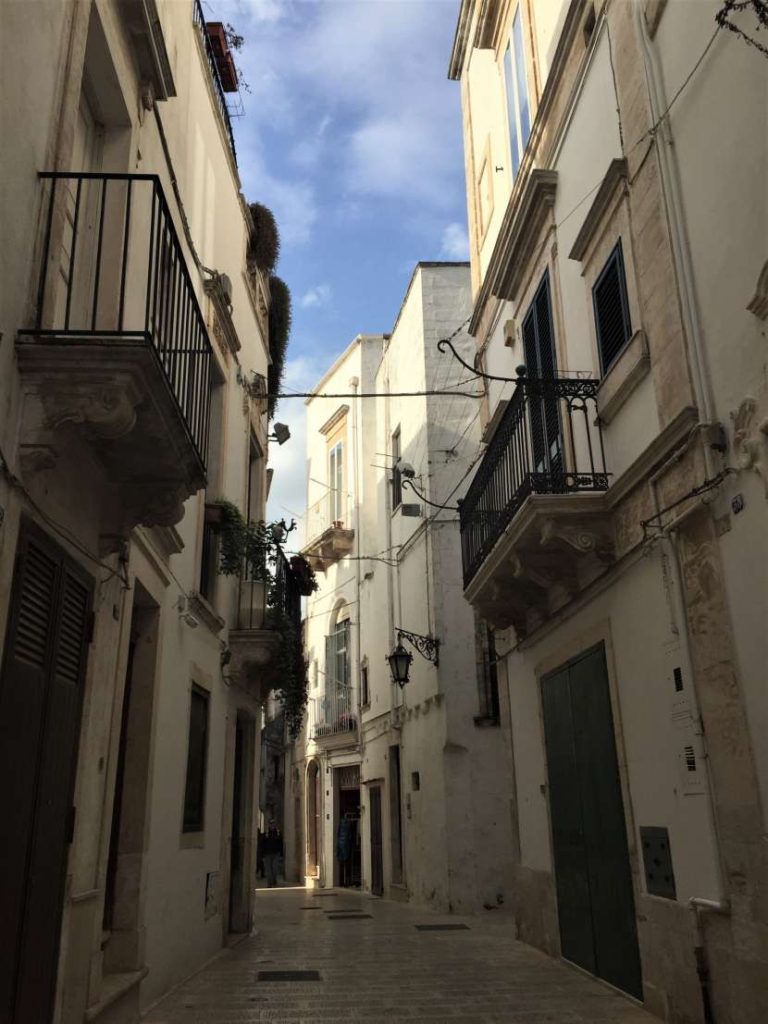
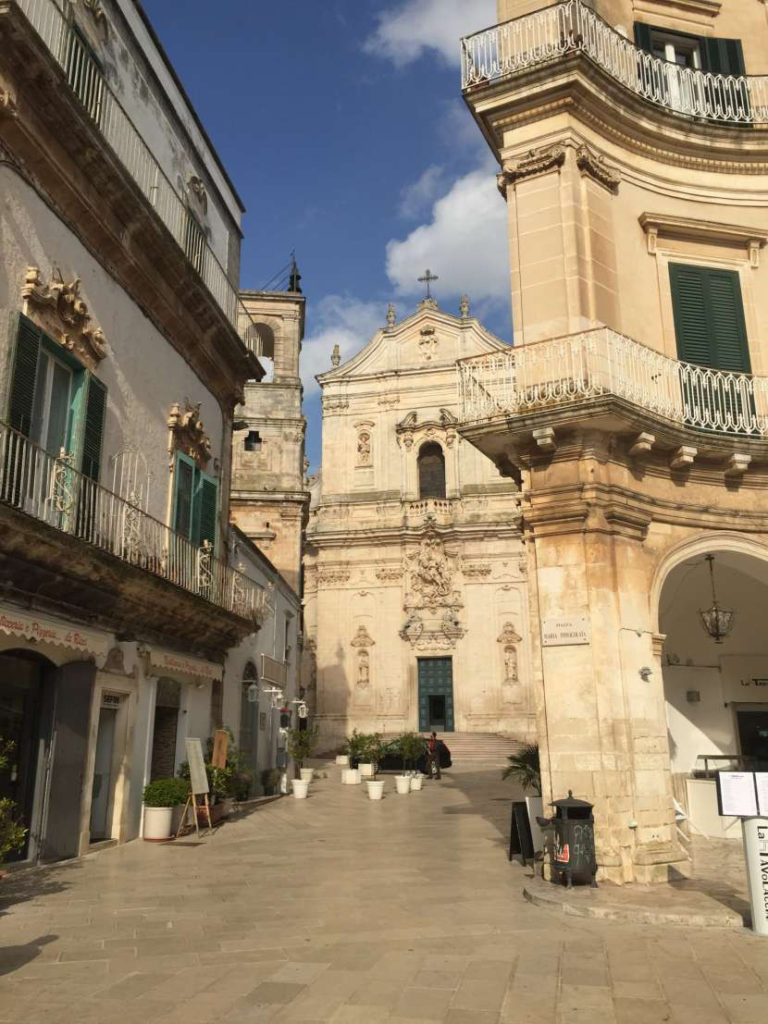
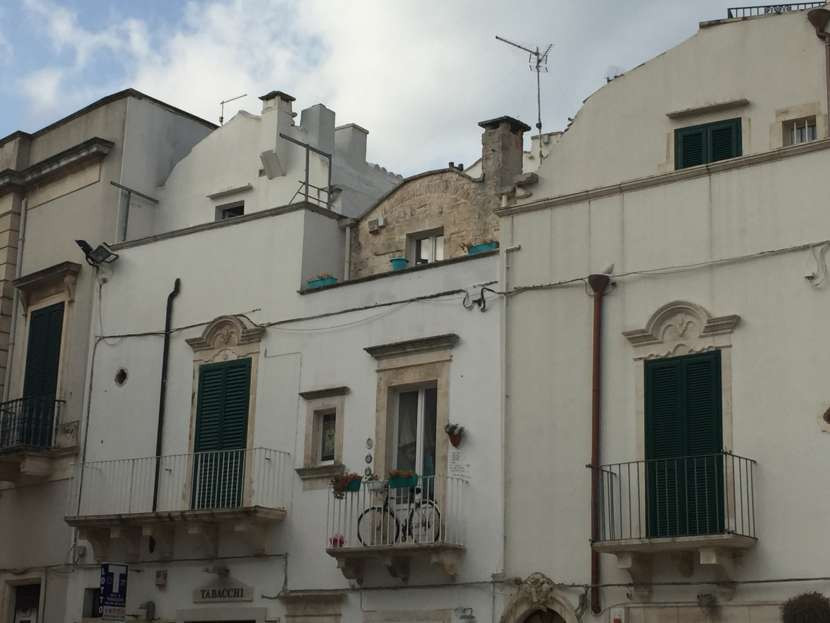
Martina Franca narrow streets
We reached Polignano a Mari during the late afternoon hours, just as it started to rain lightly. The town is built on the slopes of steep cliffs to the shores of the Adriatic Sea. We watched the beautiful and rugged stretch of beach overlooking the Ponte di Polignano bridge. Due to the rain, we boarded a small tourist train we found in the main square. We had a nice round trip in the town center and along the beach – the perfect solution for rainy weather. We then had an excellent dinner of fish and fried seafood in a great eatery called Pescaria and finished, again, with some ice cream in the nearby Caruso Note d’Eccellenza shop.
Pescaria website (In Italian, with an English menu)
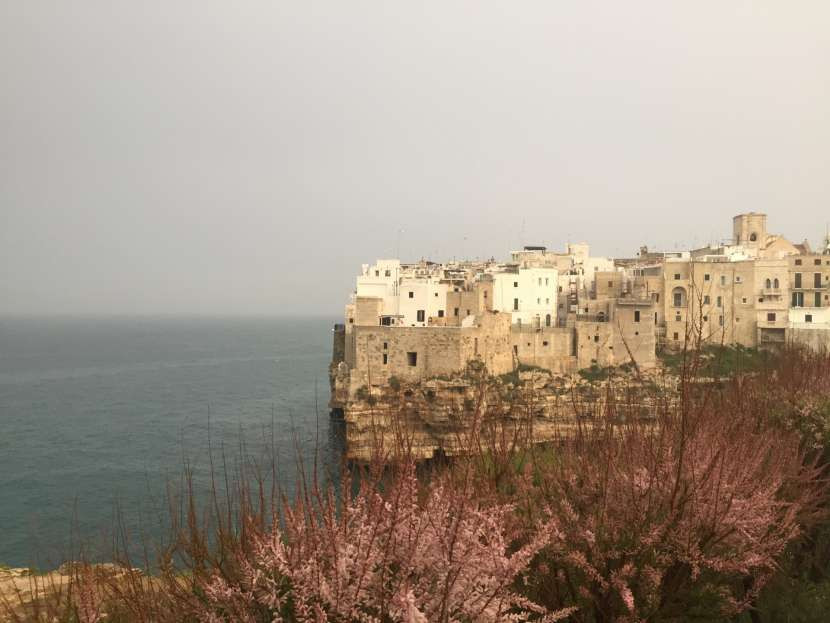
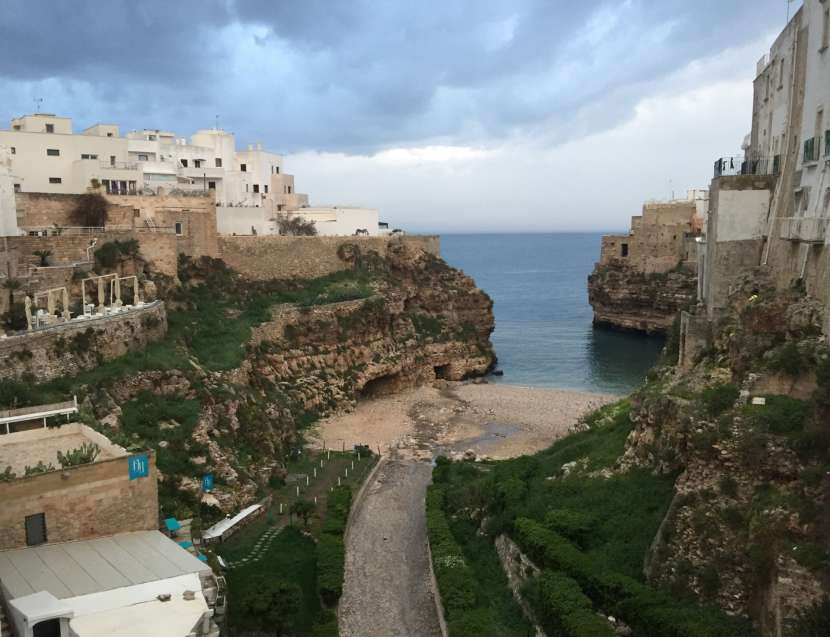
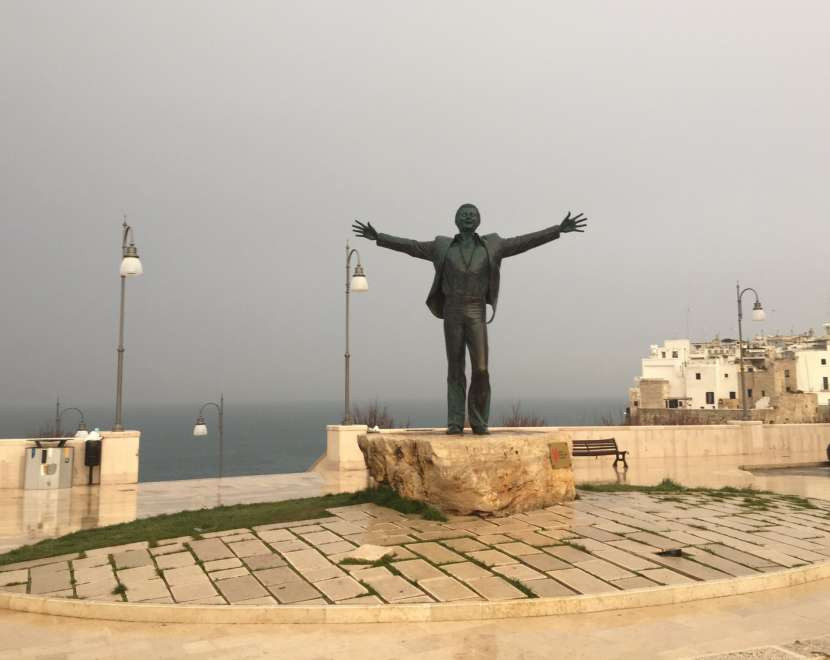
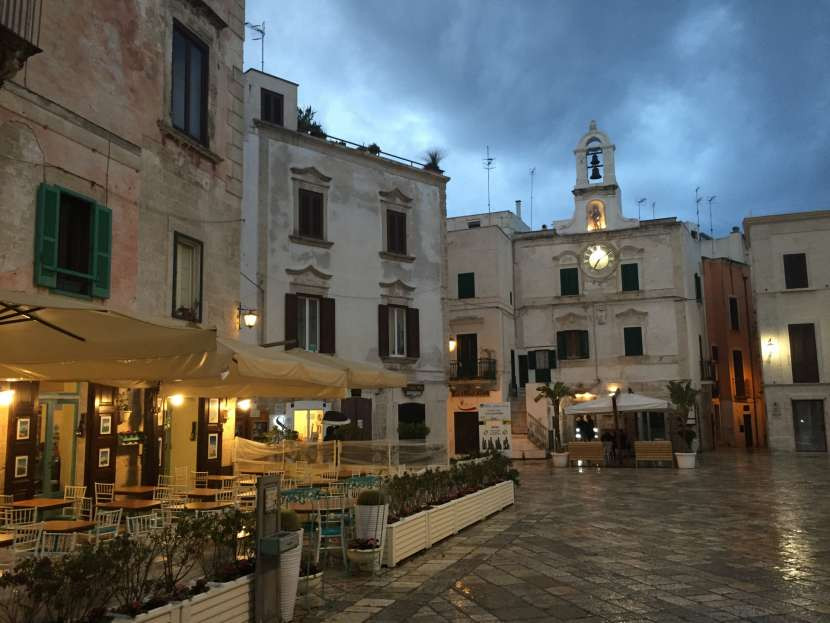
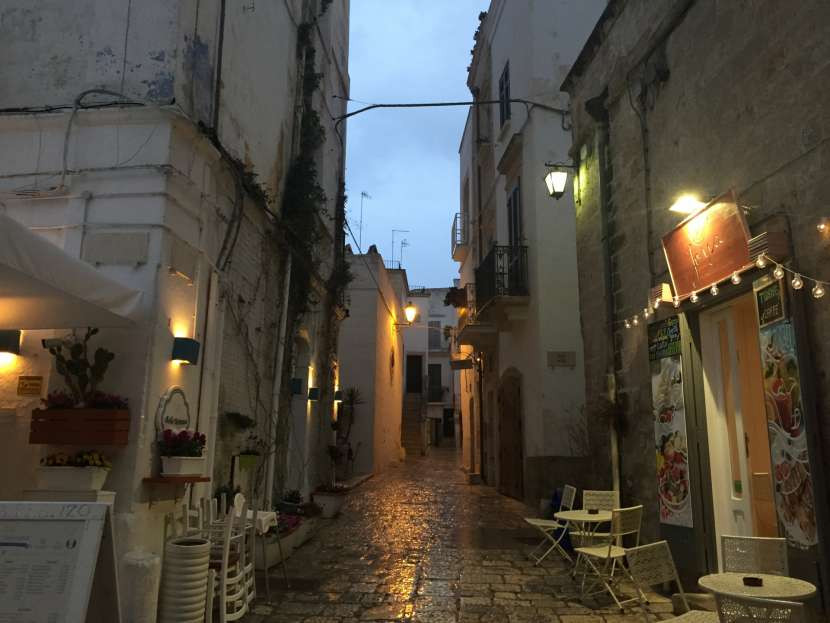
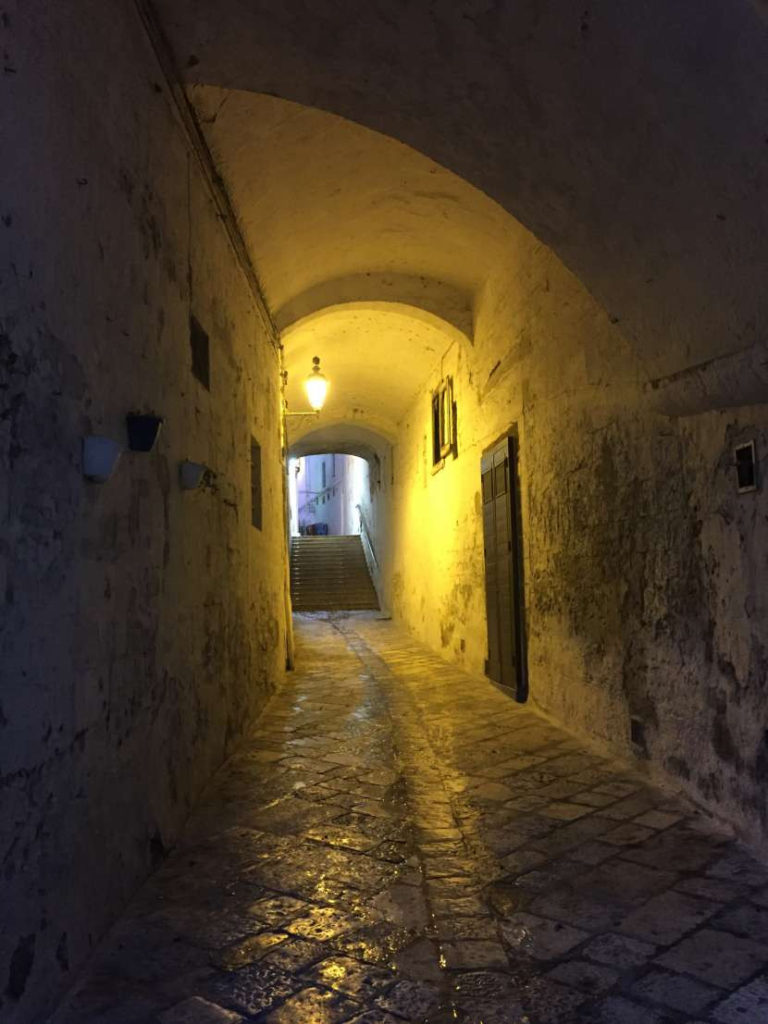
Polignano a Mari
Day 4
We started the day slowly and after breakfast left Alborobello in late morning hours and headed towards Matera – our next destination. The town is famous for its Sassi di Matera (“the rocks of Matera”) – caves that were excavated in the soft limestone from prehistoric times onwards and used over the centuries for residence and storage. Dense houses were built above the caves and the overall outcome is spectacular. Thanks to its unique look, the town was used as a filming set for several movies depicting ancient cities, such as Jerusalem in Mel Gibson’s “The Passion of Christ” from 2004. This city too was declared a UNESCO world heritage site in 1993.
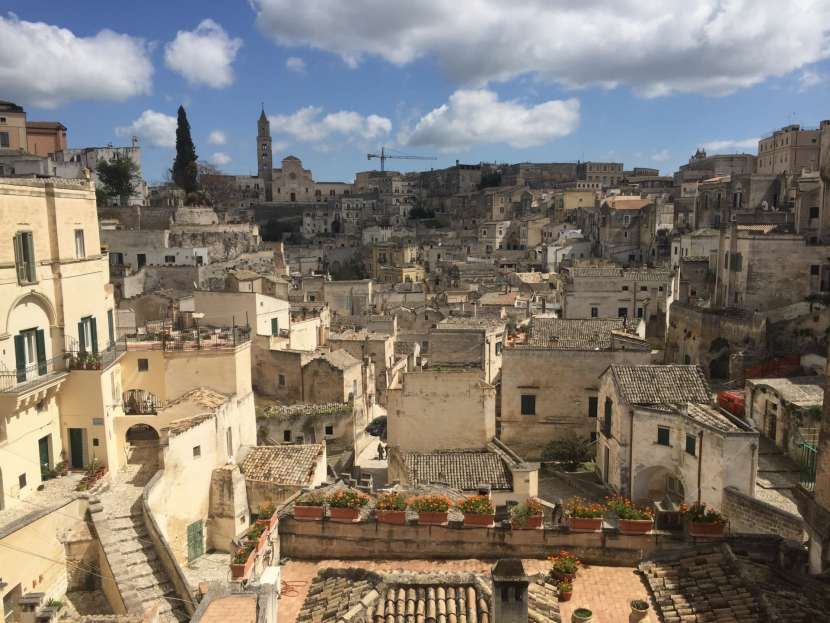

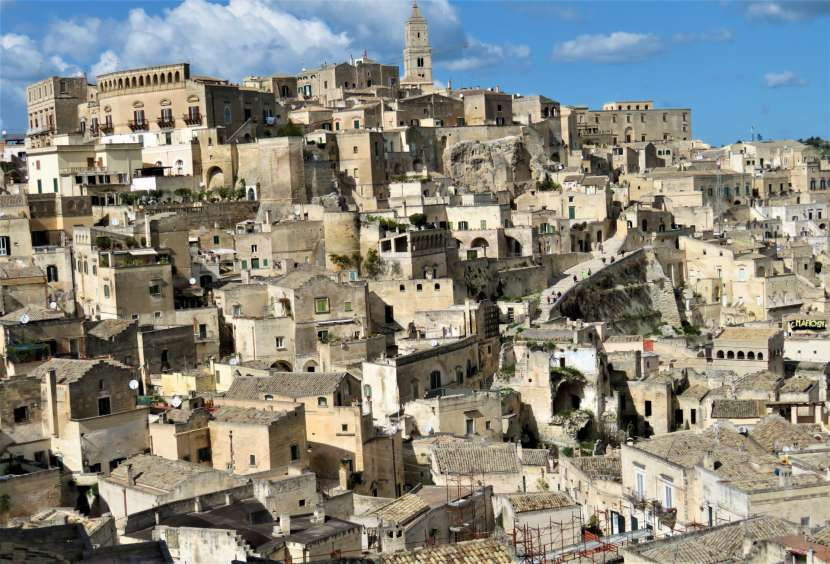
The Sassi of Matera
The Sassi are stretched over two valleys: Sassi Caveoso and Sassi Barisano. The Civita hill, overlooking then, provides great views of both. We stopped at the local tourist information office to collect some maps and get recommendations, and then toured the town center for several hours. We went up to the cathedral square on the Civita hill and several other lookout points. We visited a church carved into the rock and a restored residential cave that demonstrates how the locals used to live centuries ago.
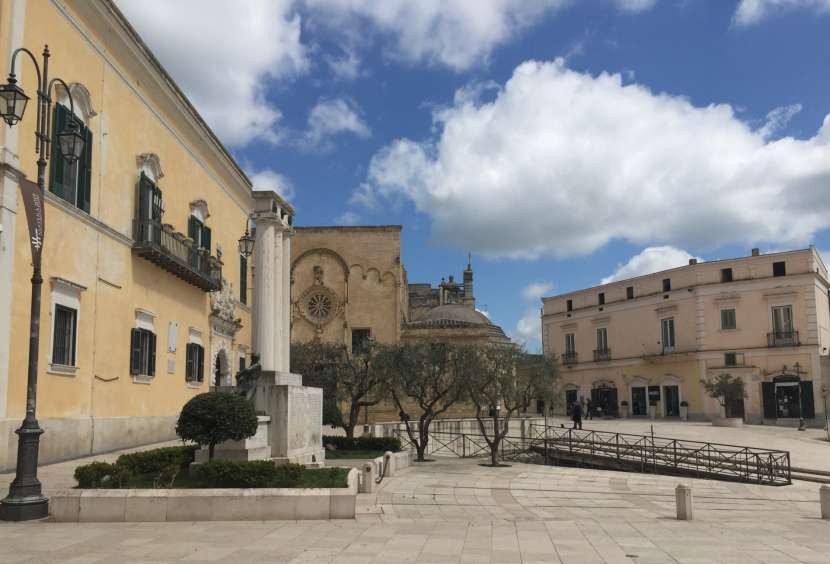
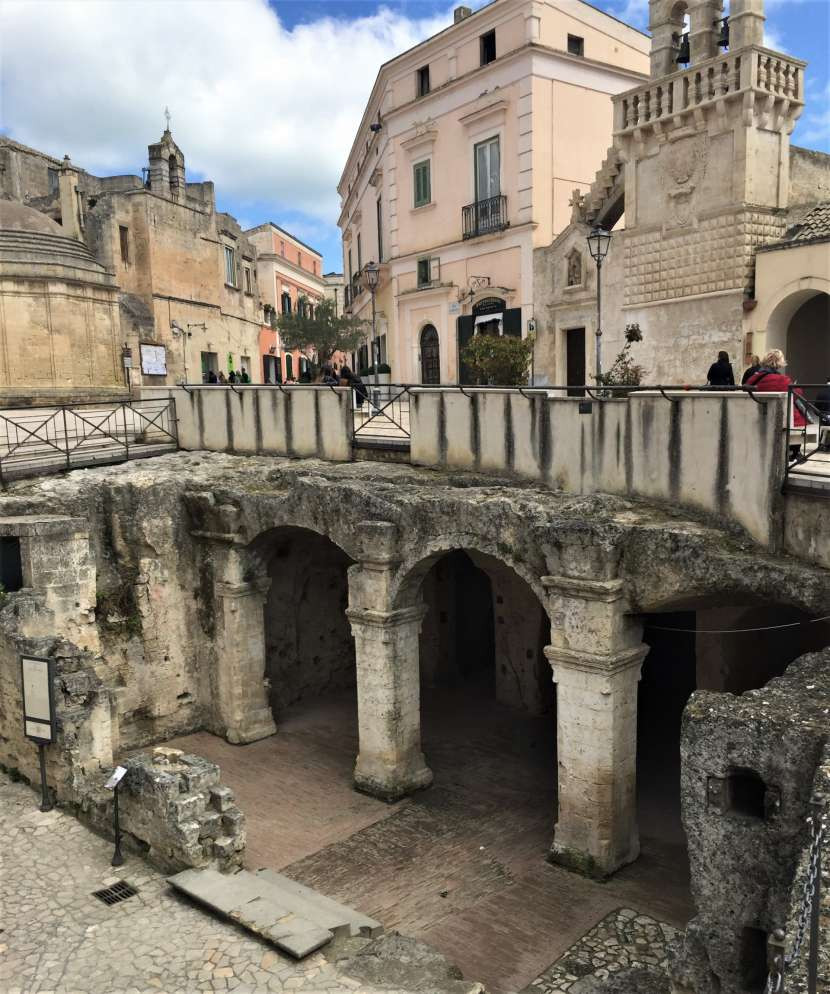
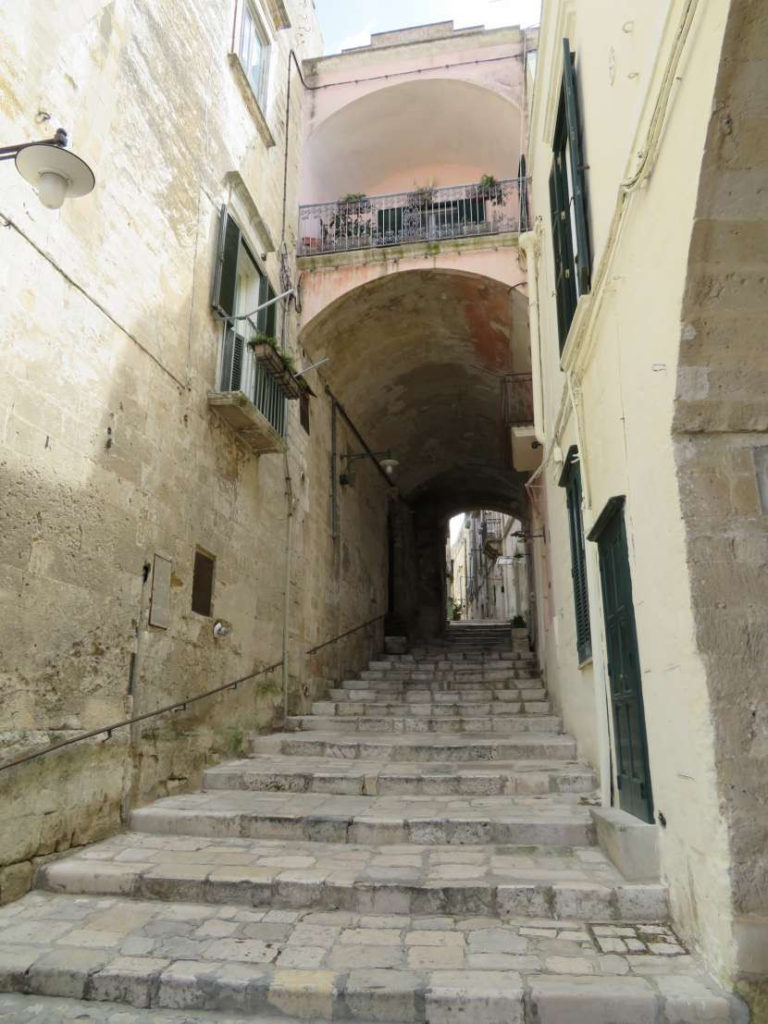
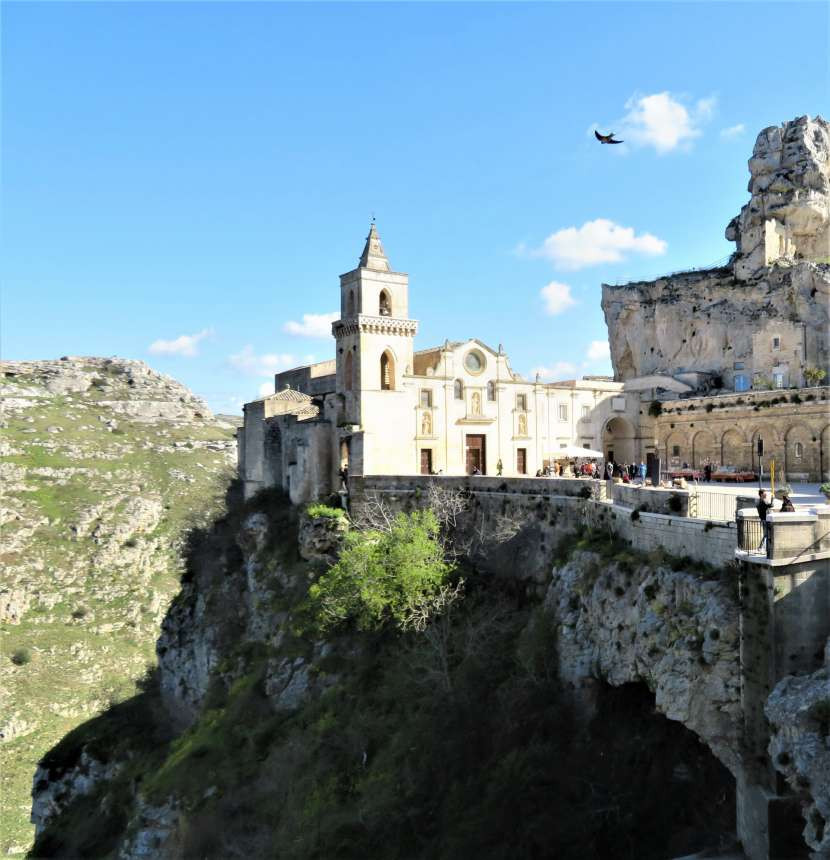
The streets of Matera
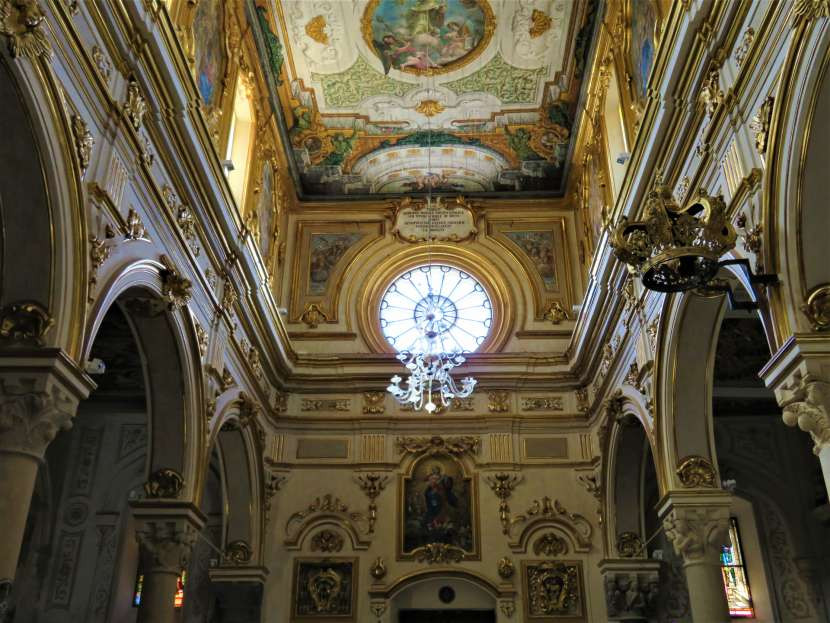
The Matera Cathedral
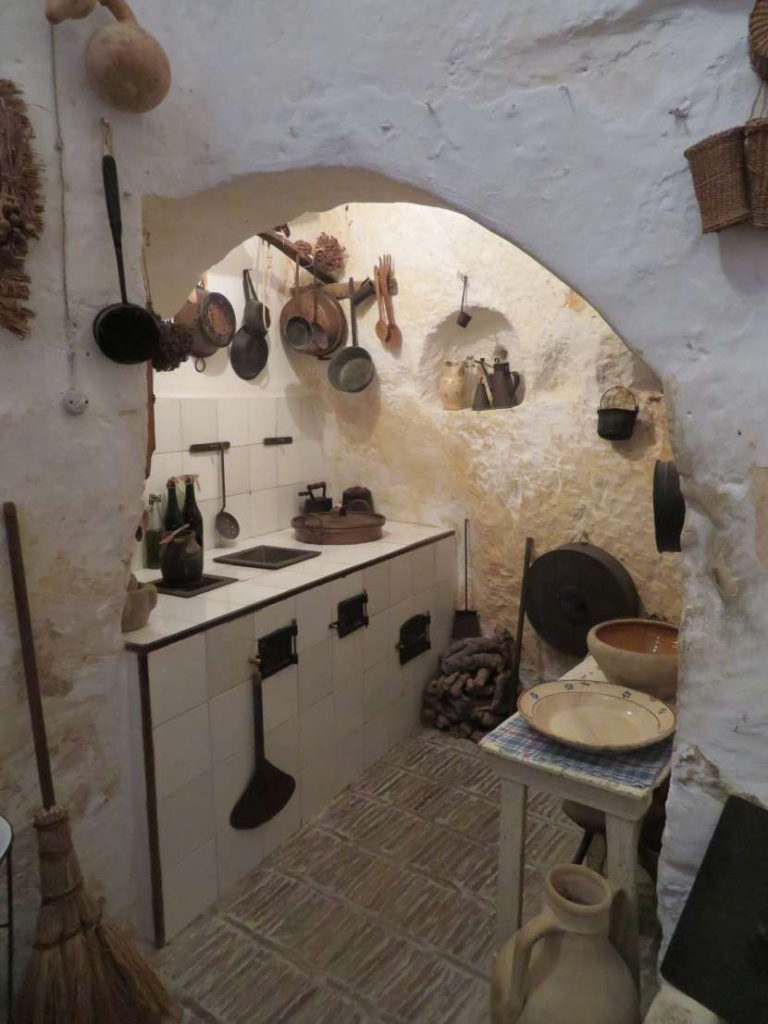
Restored residential cave
It is worth mentioning that most of the tour in Matera is done by foot and passes through steep streets and staircases, therefore it can be a bit challenging for the elderly and for small children (especially is you have strollers).
We had lunch at one of the tourist restaurants in the city center – even the simplest and most basic restaurants in Italy serve excellent food. We finished, naturally, with some excellent ice cream. It is also recommended to try the local sweets, such as the Strazzate – chocolate and almond cookies originally made for Christmas.
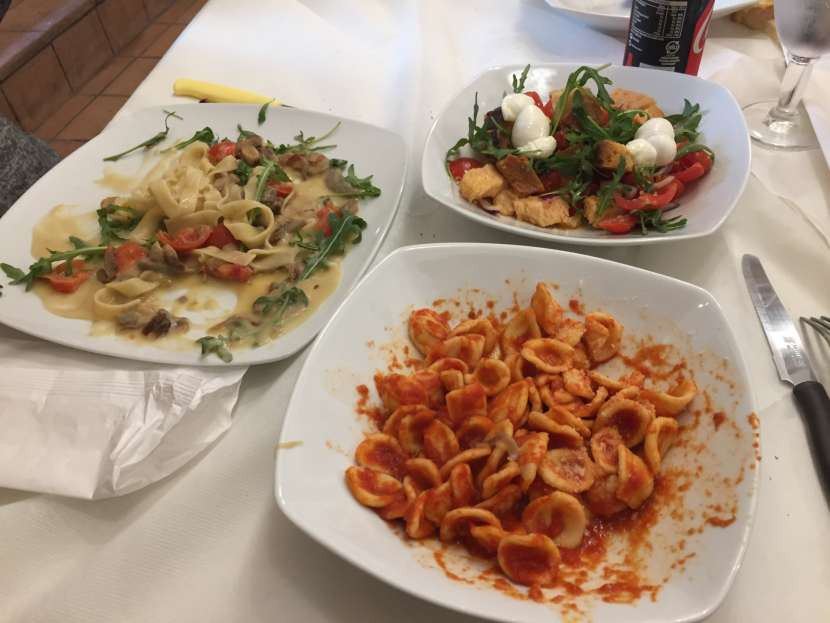
Italian food – simple and delicious
All in all, we had a great time in Apulia. It is usually not considered one of the top touristic areas in Italy, but it has a lot to offer. Although our trip was short and there are many other sites we did not get to visit, such as Lecce, Ostuni, Peninsula Gargano and more, we will surely come back again.
We left Matera at late afternoon and set out on a 3.5-hours’ drive to Sorrento. We arrived late to the villa we rented for the next three nights, and after settling in went out for a quick dinner at a nearby pizzeria.
We rented three apartments in Villa Flavia, located in Sant’Agnello just above Sorrento – two family units and a double unit. The villa itself is beautiful, especially the garden and orchard around it, and the coastline and Mount Vesuvius views from the second-floor balcony are superb. However, while the apartments inside the villa itself were spacious and well-equipped, the family apartment located in the adjacent building was smaller and less comfortable. Also, the road leading up to the villa is narrow and slightly inconvenient to access, especially for a vehicle as large as we had. The price of a 4-persons apartment was 465€ for 3 nights (without breakfast).
Day 5
On our previous trip to southern Italy we visited Capri. However, the weather then was cloudy and gray, so we decided to return to Capri again. This time the weather was perfect – the sun was shining and the sky were blue and crystal clear.
We drove to the small port of Sorrento and parked our cars in one of the paid parking lots nearby. There are several companies that operate ferry services to Capri and back at different hours, the last ferry from the island back to the mainland leaves at around 6pm or 7pm (depending on the season) – so you should plan accordingly and start the day early. When we got to the ticket office, we found out the only remaining round-trip tickets were for returning at 3pm, which would not have left enough time on the island. We sadly thought that we would have to give up, but one of the local tour guides told us we could buy the return tickets at Capri port. We did as he suggested – bought one-way tickets from Sorrento to Capri, and as soon as we got to the island bought the tickets back. There was indeed no problem with tickets availability in Capri, so I am not sure why we could not buy the same tickets in Sorrento to begin with… In any case, since Capri is one of the busiest tourist destinations in the area, especially during the high seasons, it is highly recommended to book tickets in advance online, or at least arrive early to avoid potential issues.
The cruise from Sorrento to Capri on the big ferry ships takes around half an hour. Once we arrived at port Marina Grande, we bought tickets for a cruise around the island which included a stop at the Blue Cave (The Blue Grotto) – one of the most famous tourist sites in Capri, as well as Italy in general. There are several companies and ships operating such a cruise, you can also rent a private boat if you wish. We preferred a larger boat with a shaded roof and toilets – the price was 18€ per person plus additional 14€ to enter the Blue Cave.
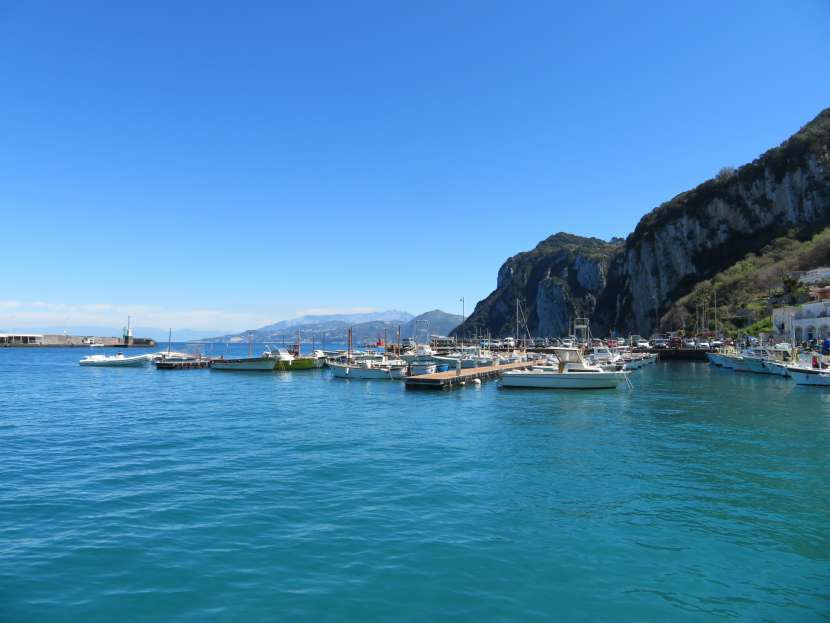
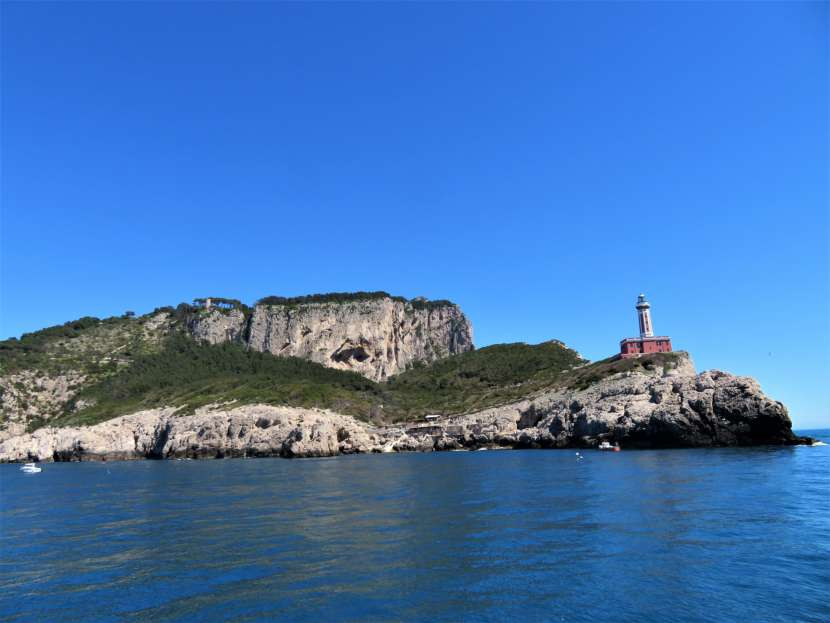
Sailing around Capri
The cruise lasted for an hour and a half and it was great. We circled around the island, viewed its beautiful rugged beaches and passed through the famous arch of one of the Faraglioni – three large rock pillars jutting out of the sea next to the shore, one of the best-known and most photographed sites in Capri.
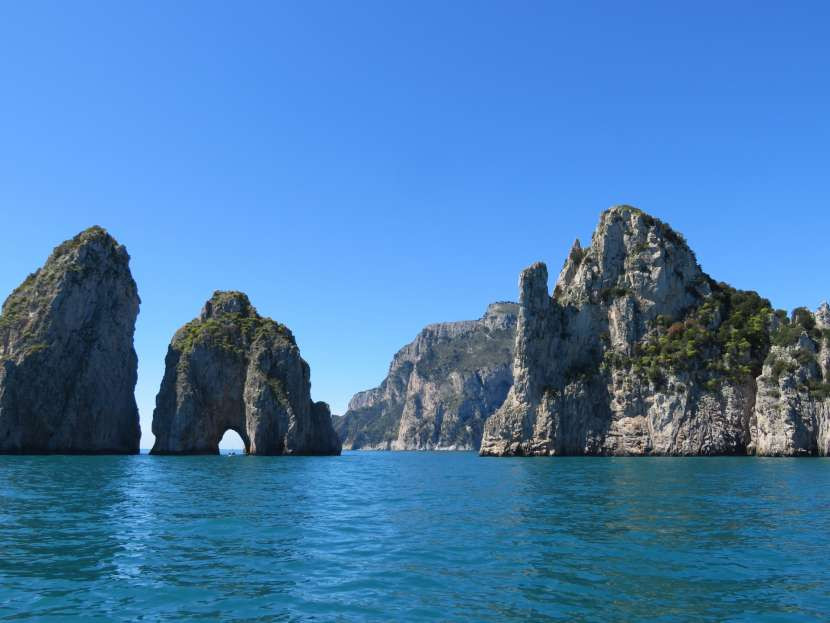

Passing through the Faraglione stone arch
The Blue Grotto is a “mythological” tourist attraction that has been known since ancient classical times. It is a large natural cave carved into the rock by the sea waves. The entrance to the cave is through a small opening less than a meter high – therefore when the sea is stormy, it is not possible to get in. Thanks to the narrow entrance, which is partially submerged under water, the sun light that penetrates the cave through the sea water paints its interior in a spectacular deep blue color – hence its name and fame. In ancient times, the cave served as a bathing place for wealthy Romans and was even the private pool of emperor Tiberius, who lived in Capri during the last ten years of his reign.
Entering the cave is possible only using small paddle boats. Tourist ships set anchor near the entrance, the visitors then move to the small boats that are operated by local rowers who skillfully navigate them into the cave through the narrow opening while singing serenades in Italian (for a tip of course…).
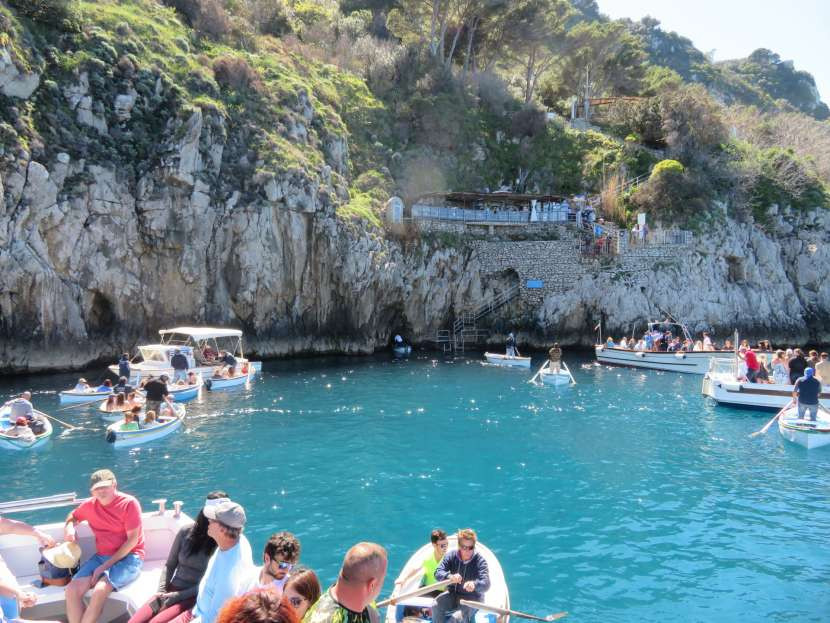
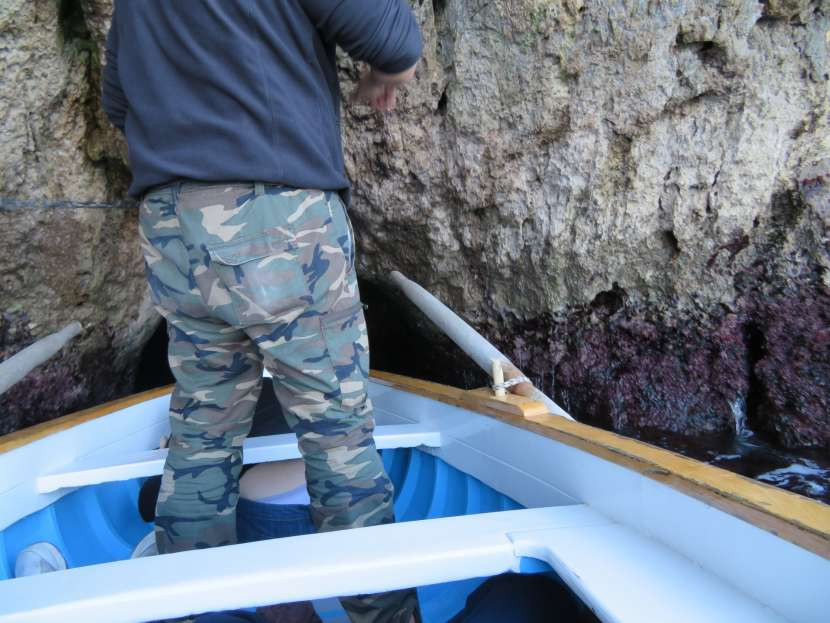
Entering the Blue Cave
Although the experience is very touristic and overall we spent only a few minutes in the cave itself, while inside the flickering blue light flooded the air and created an enchanted and breathtaking atmosphere – so we were able to understand how did the cave become so famous.
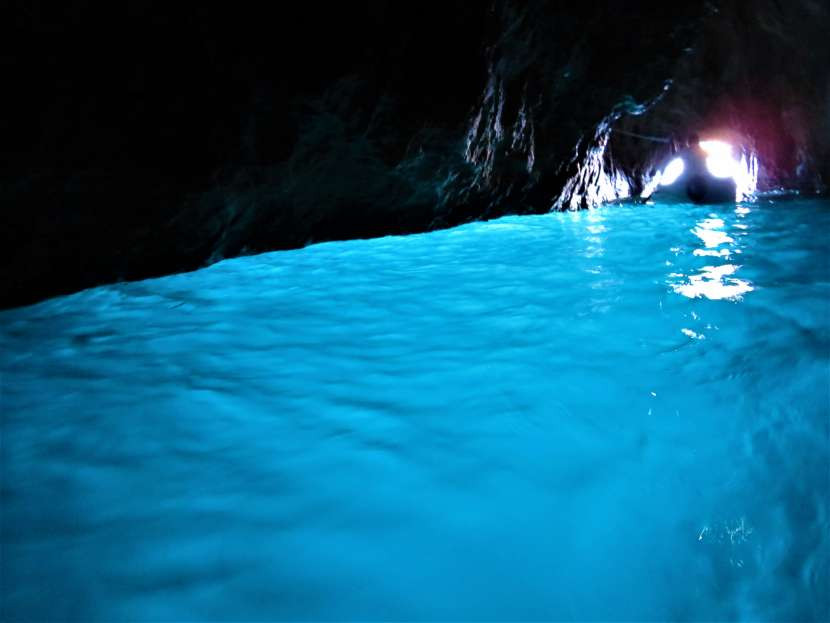
Inside the Blue Cave
Capri has two main towns: the larger one is called Capri too, while the smaller one is named Anacapri. Once the cruise was over, we took a taxi from the port to Anacapri – the taxi fare inside the island is usually around 20-30€. There is also a cable car (Funicular) that connects the port and the town of Capri, as well as small public buses designed to travel in the steep narrow roads of the island. However, at the time of our visit, the cable car was not working and there were long queues for the buses – so using the cute open Capri taxis was the best option.
Want to share your travel stories in OurStoriz too ?Click HERE to register for free and start telling your story |
We had a quick lunch in one of the tourist restaurants in Anacapri, and then took the cable car to the 600-meters summit of Monte Solaro – the highest point of the island. The seats of the open cable car fit a single person, small children can join an adult. During our previous visit to Capri, the entire mountain was immersed in a thick cloud of fog. While it was fun riding the cable car inside a cloud at the previous time, we could not see anything when we got to the top. This time visibility was perfect – the whole island and its coastline were spread out in front of our eyes and the views were spectacular.
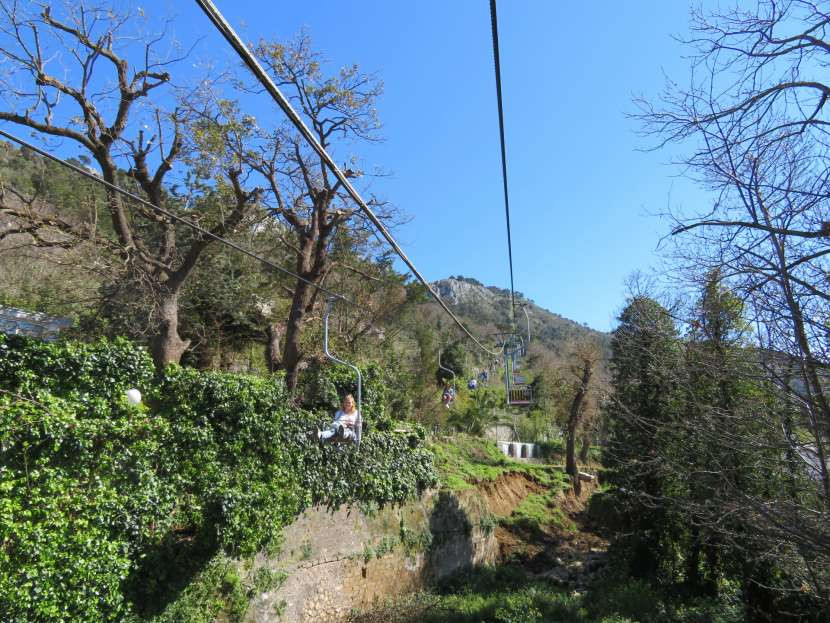
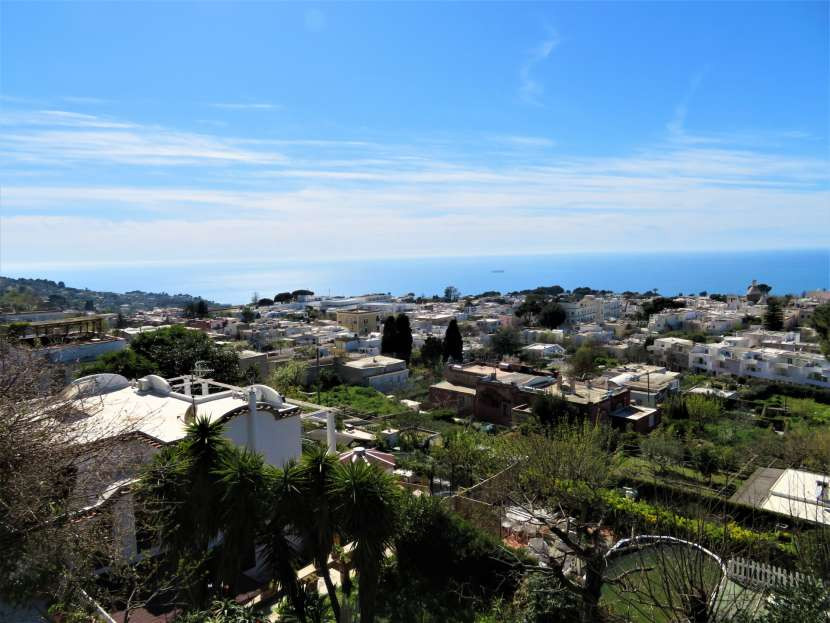
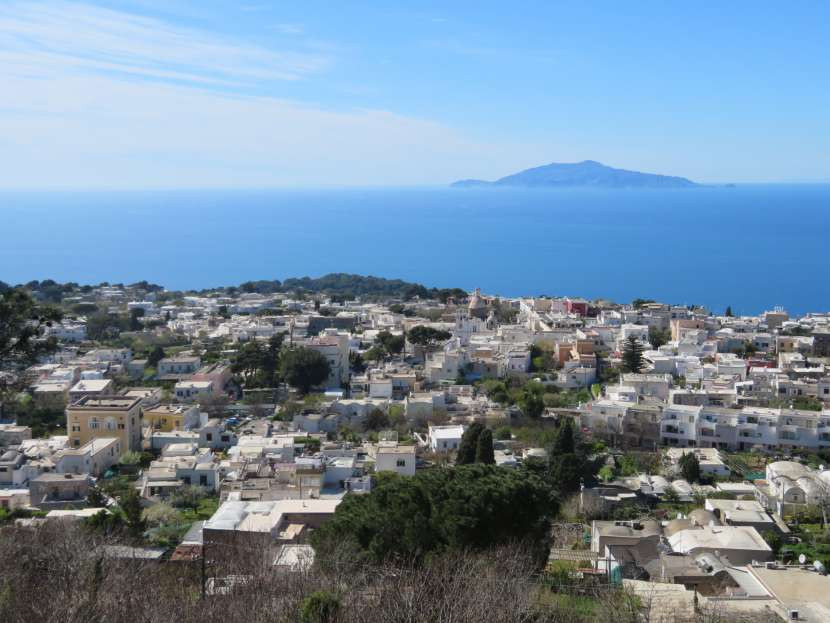
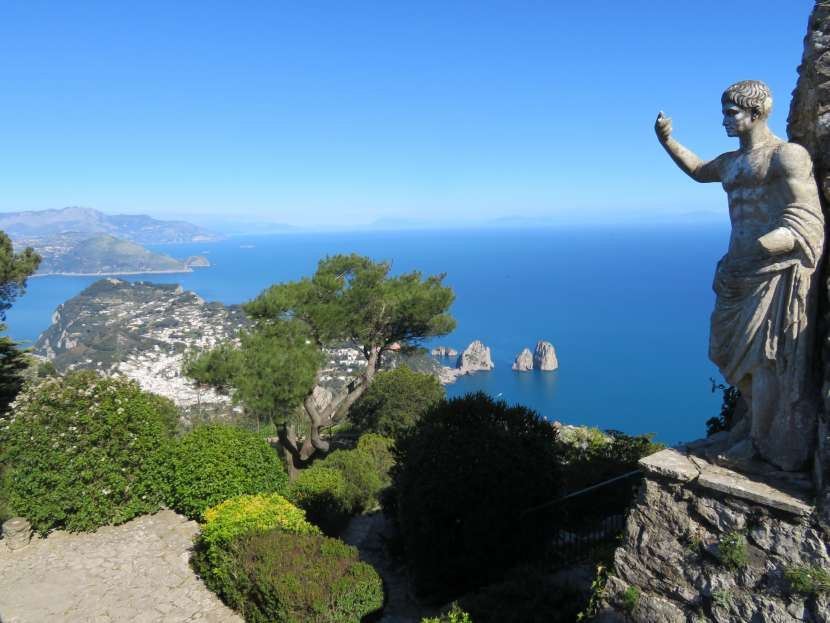
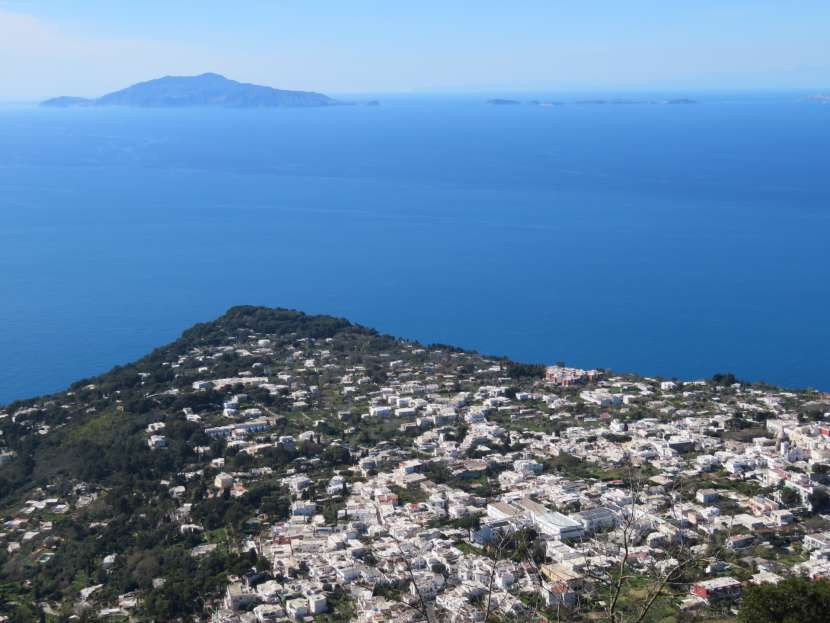
The cable car to the summit of Monte Solaro and the views from the top
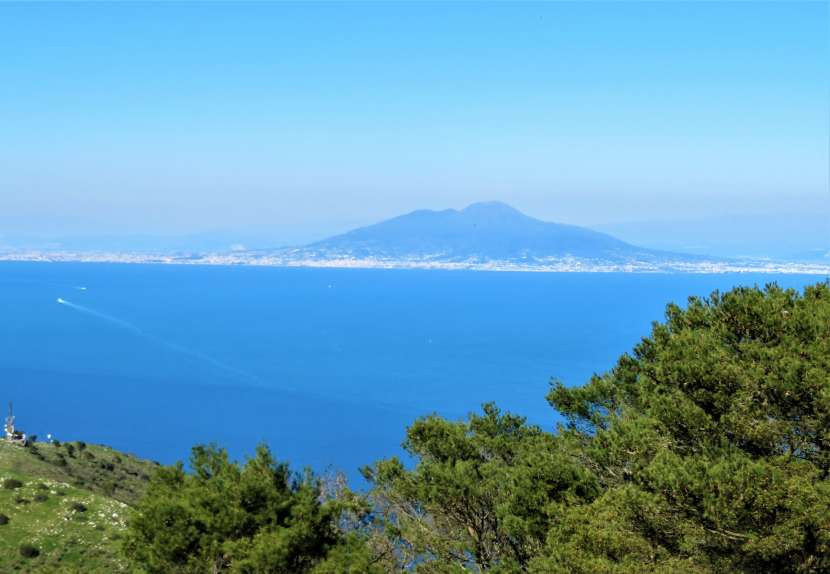
The Bay of Naples and Mount Vesuvius
We paused to rest and had some snacks, ice cream, coffee and Limoncello in the café at the top of the mountain. We then took the cable car back to Anacapri and returned to Capri with a taxi. We wandered a bit through the narrow streets and alleys and walked to the observation point at the Gardens of Augustus, which provide a great view of the shoreline and the Faraglioni – through which we cruised a few hours earlier.
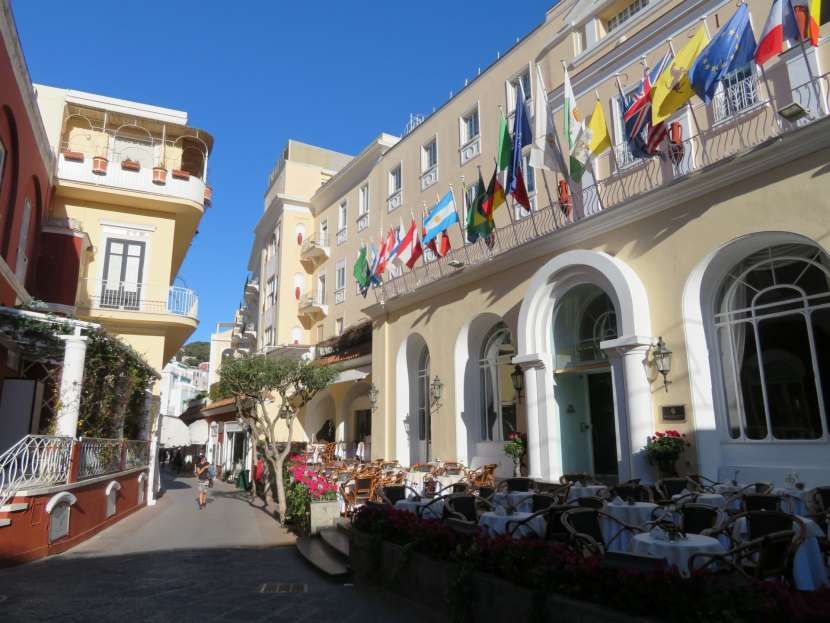
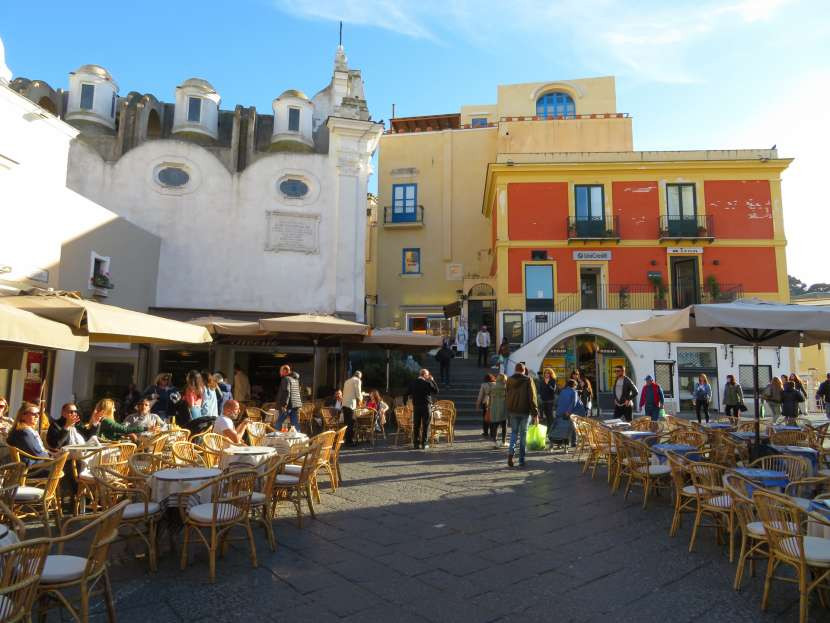
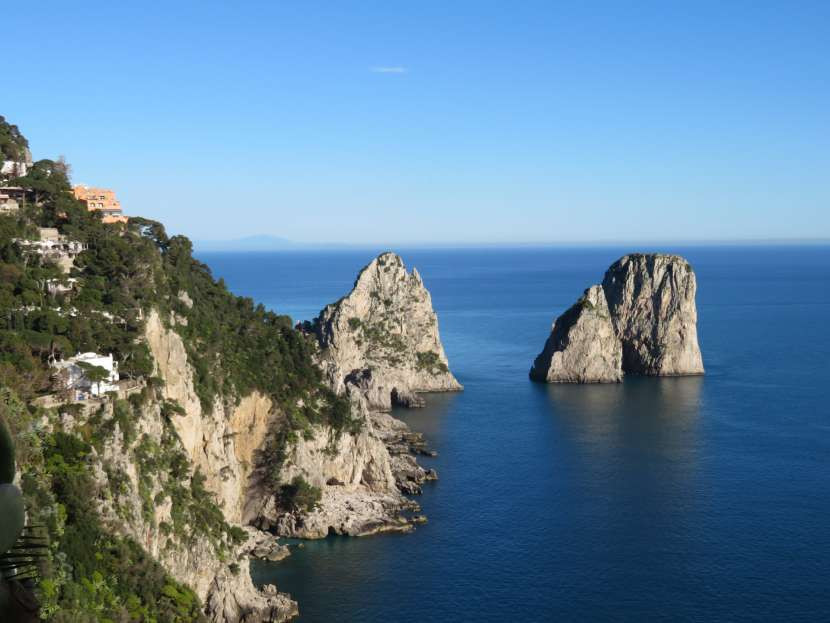
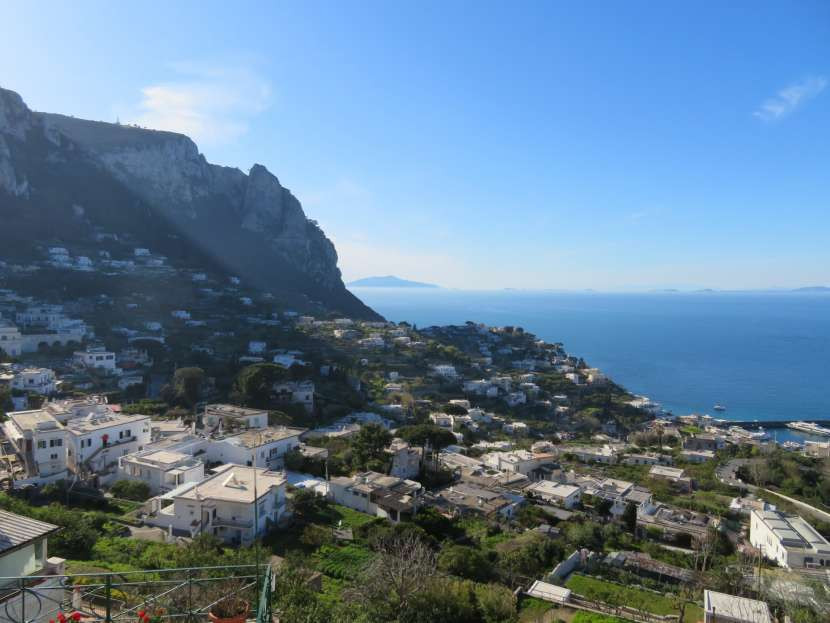

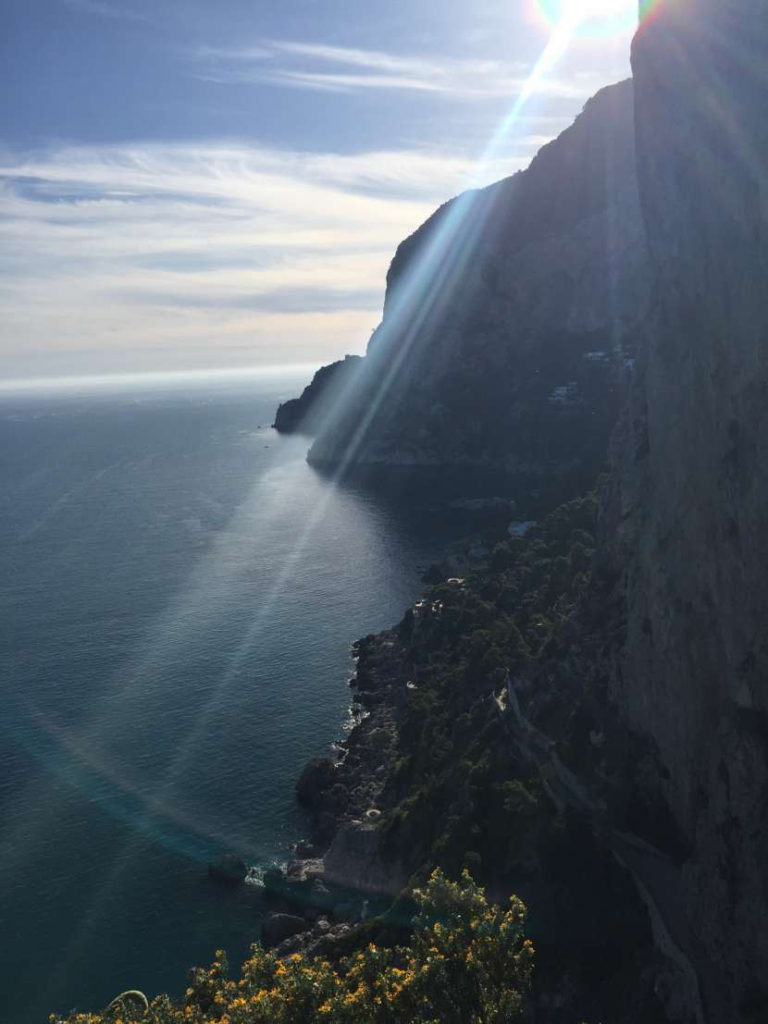
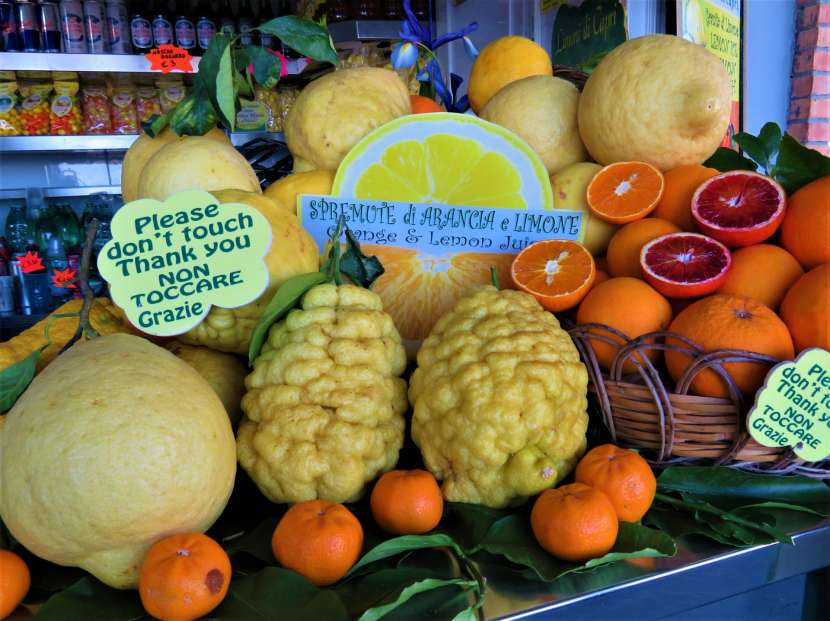
The town of Capri and the Gardens of Augustus
We then returned to the port and boarded the ferry back to Sorrento.
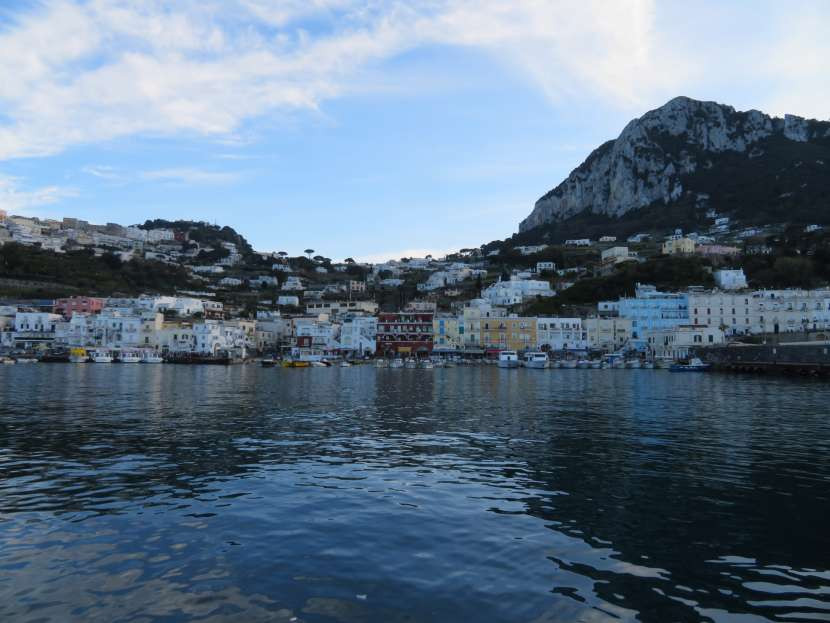
Leaving the port of Capri
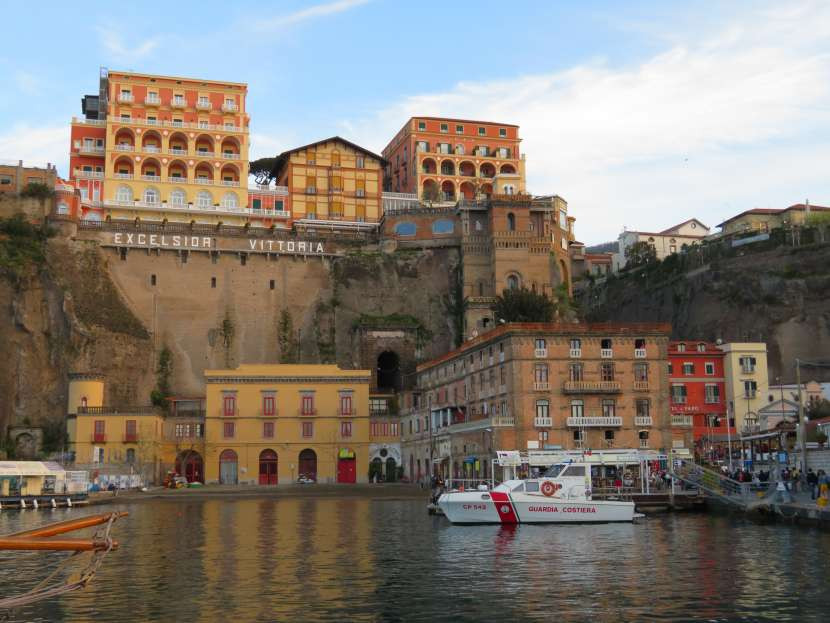
Arriving at the port of Sorrento
There are several hiking routes in Capri, although we did not have enough time during our visit. One of the trails leads to the remains of Villa Jovis. The villa, built on top of a cliff high above the sea, was inhabited by emperor Tiberius – who conducted a life of promiscuity and debauchery here, as described in the writings of Roman historians.
We had dinner at Ristorante Bagni Delfino – one of the best (and most expensive…) restaurants in Sorento. The restaurant is known mainly for its fish and seafood dishes, as well as a very large selection of wines. The meal was indeed one of the best we had during our trip. The restaurant is located in Marina Grande (not to be confused with the port of Sorrento). Getting to the restaurant with a car, driving through the steep narrow road that winds down, is a bit problematic since there are few parking spaces below, so my recommendation is to arrive by taxi or park the car uphill and walk down by foot.
Ristorante Bagni Delfino (Facebook page)
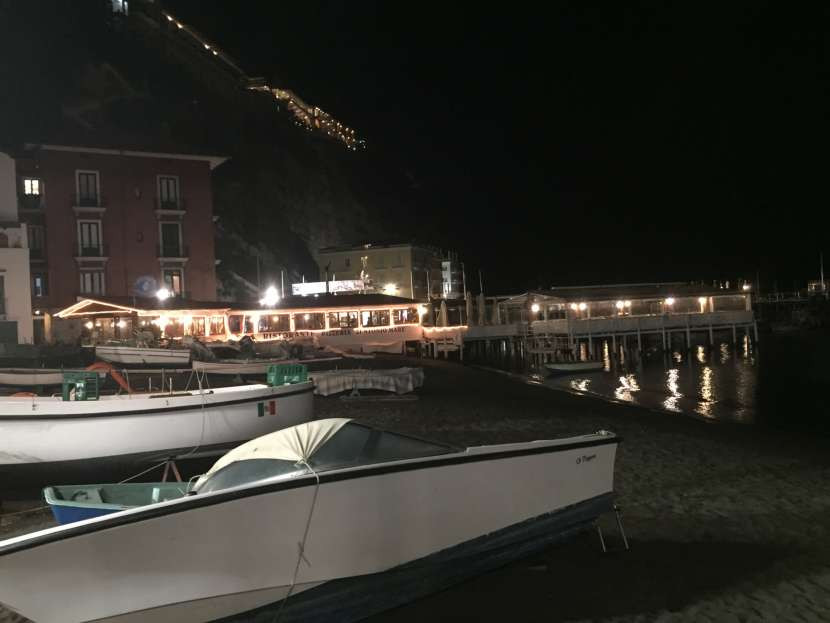
Marina Grande in Sorrento
Day 6
We spent the morning traveling along the Amalfi Drive – one of the most beautiful and well-known scenic routes in Italy. The most convenient way is to travel by car, however the road is narrow and there might be congestions and traffic jams (especially during high season). Also, in some cases it might be problematic to find parking spaces at the towns and sites along the way. Another option might be traveling by public transportation, or sailing between the towns by boat, however this is usually less convenient for a family with kids – and you might be missing some of the beautiful views along the way.
This is the second time we visit the area. Our first stop this time was the small and beautiful inlet of Praiano. We had a light meal at one of the local restaurants and took a short hike on a path climbing up over the beach.
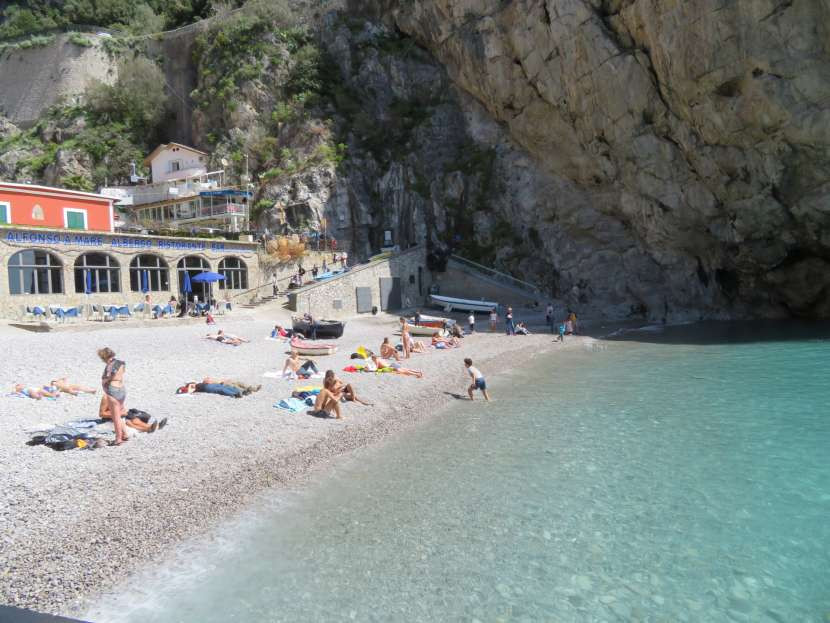
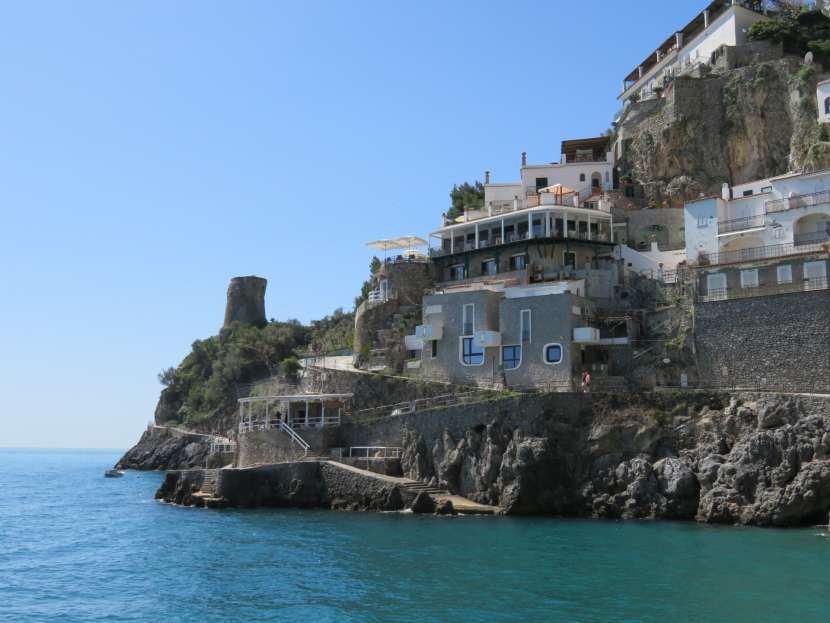
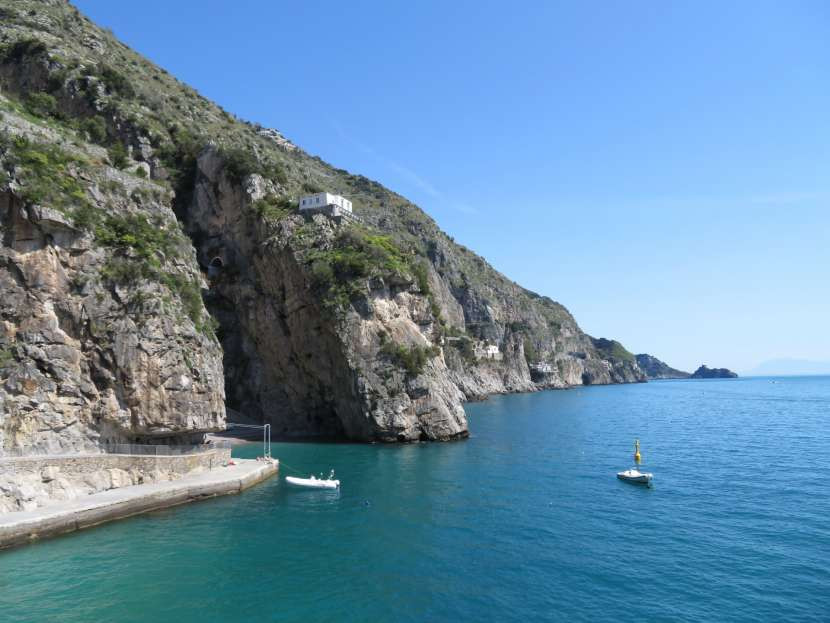
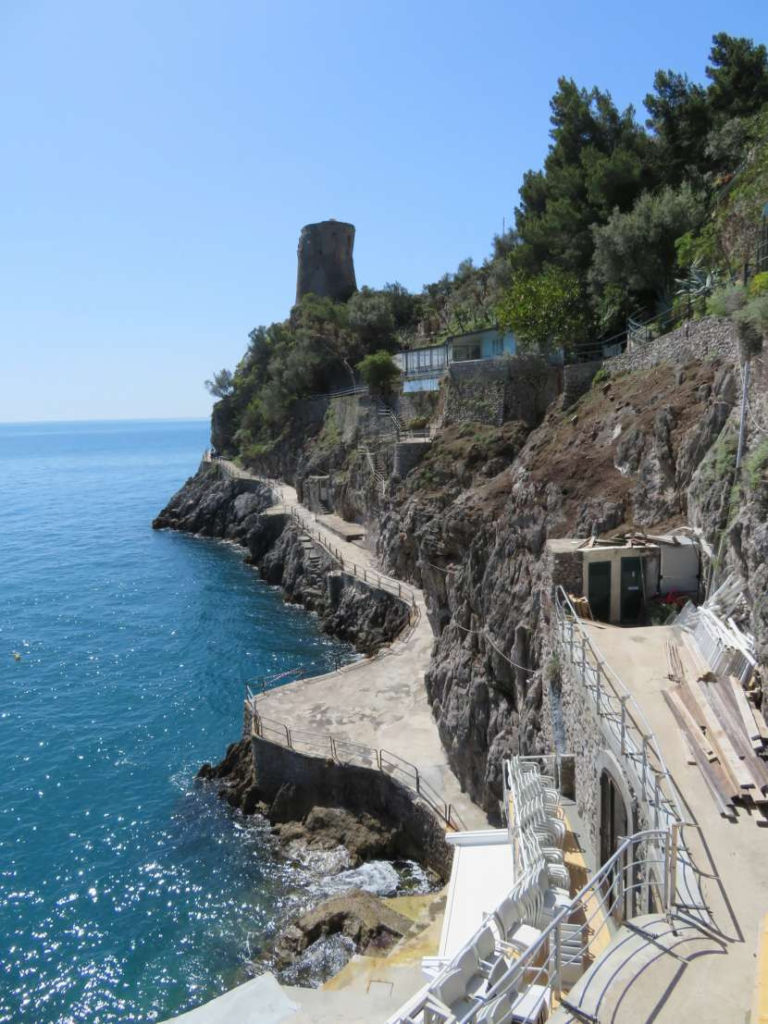
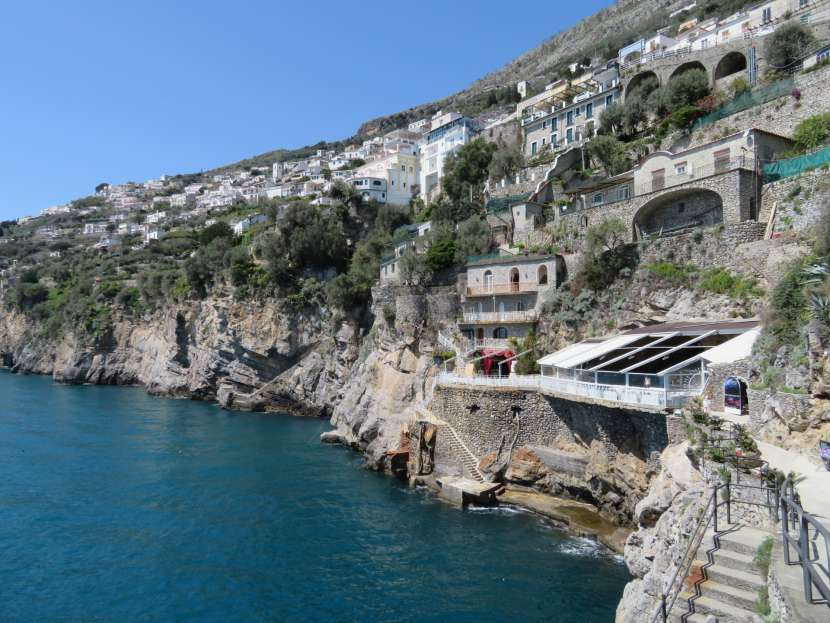
The beautiful Praiano beach
We then continued driving on the road. We decided to skip Amalfi itself, which we visited in our previous trip, and instead proceeded directly to Ravello.

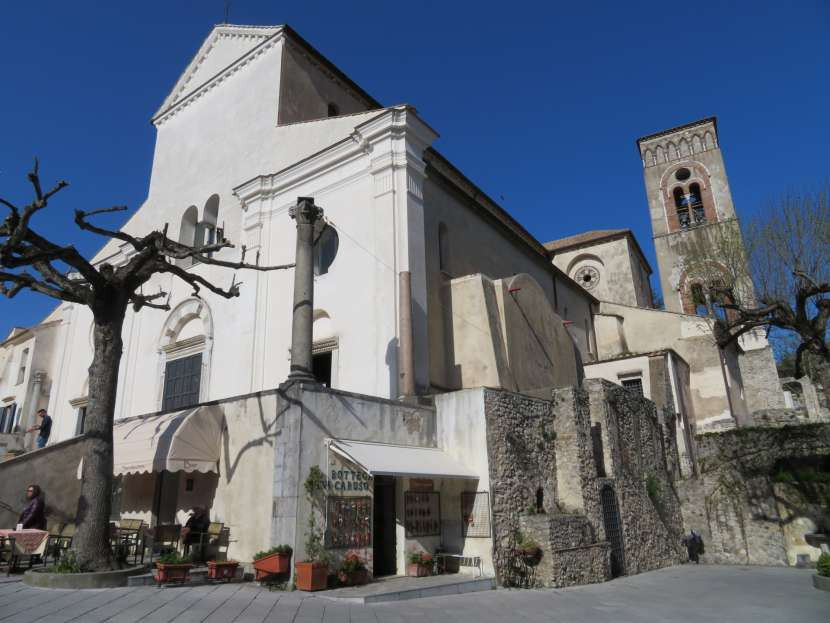

The main square at Ravello
We walked around the town center, had a quick look into the nice cathedral and visited Villa Rufolo and its beautiful gardens. The villa, that has magnificent views of the coastline, was built by the rich Rufolo family in the middle ages. Next generations of the family continued living in the villa for centuries. In 1880 it was visited by the famous composer Richard Wagner who was very impressed by the beauty of the place and was inspired by it when composing some of his Operas. Nowadays the villa hosts concerts and music festivals throughout the year.
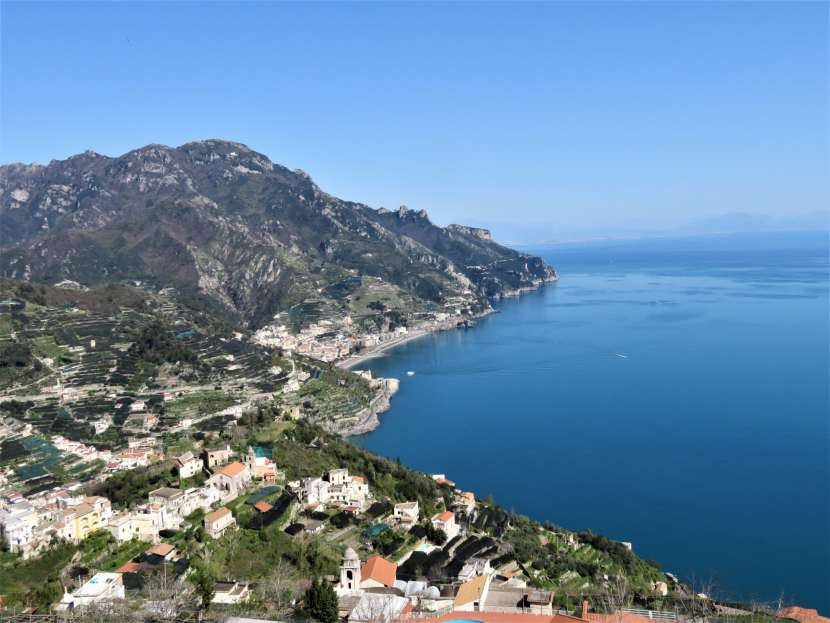
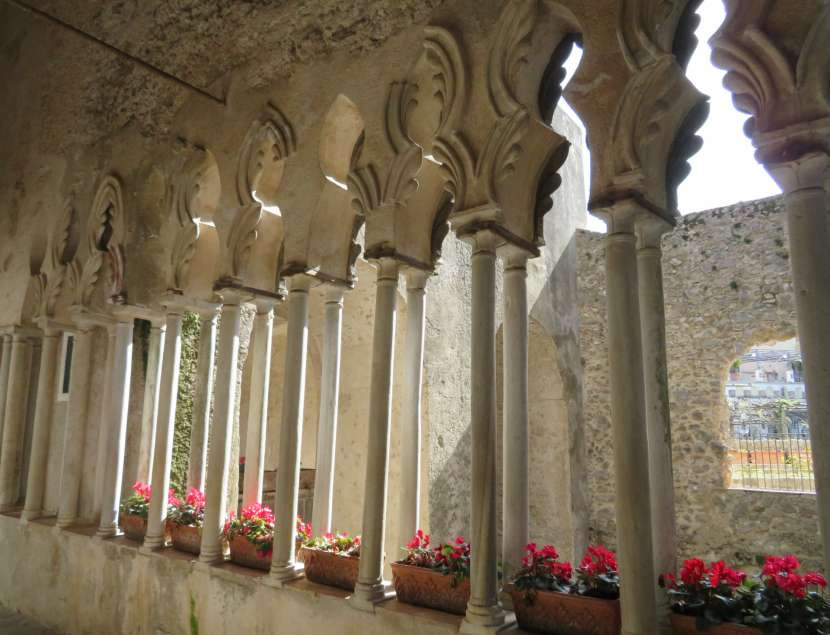
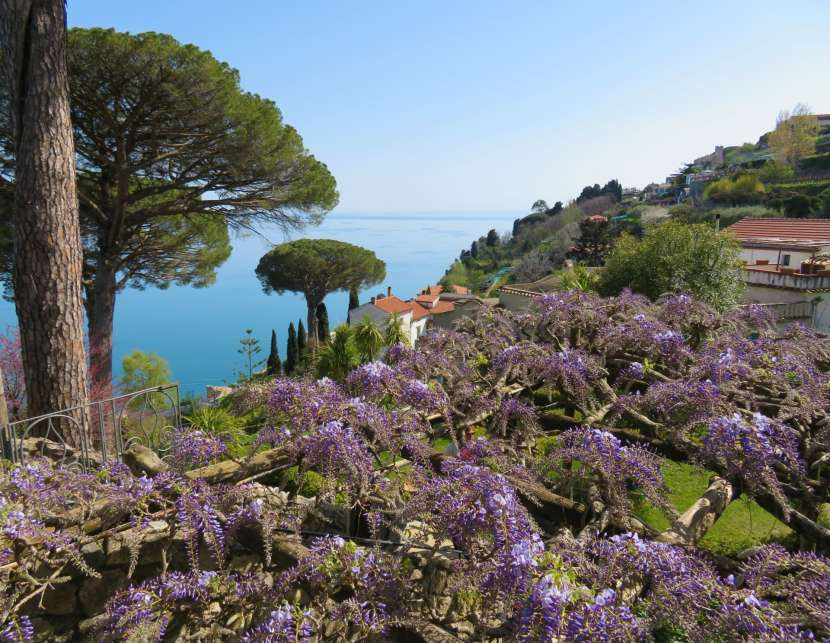
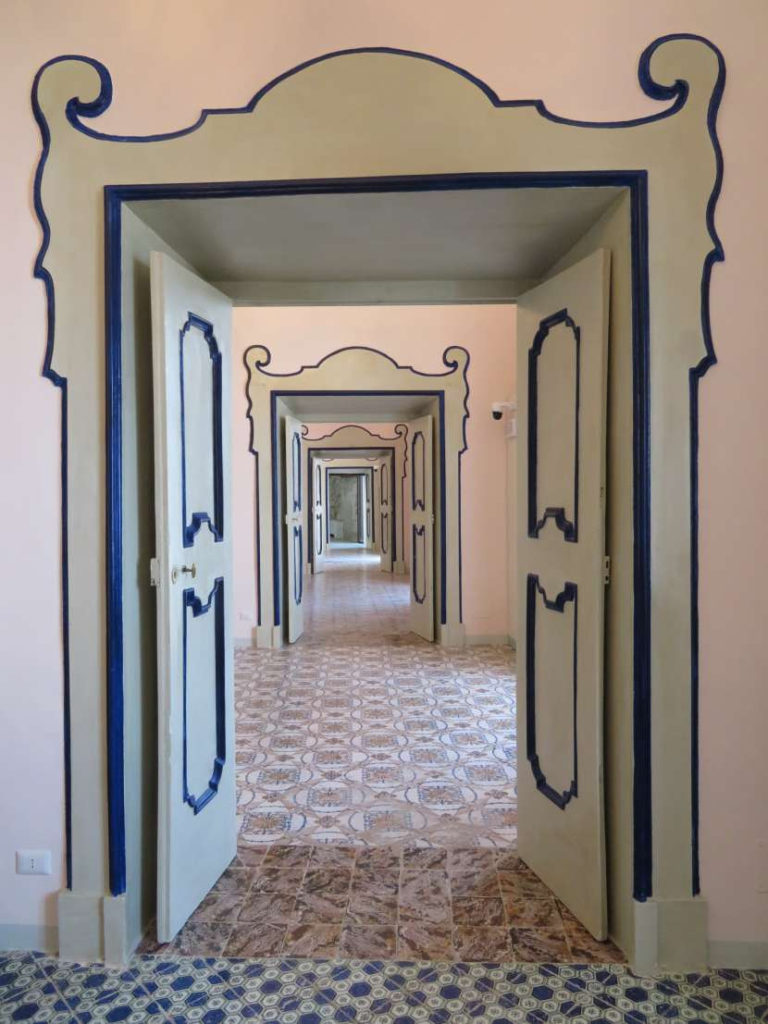
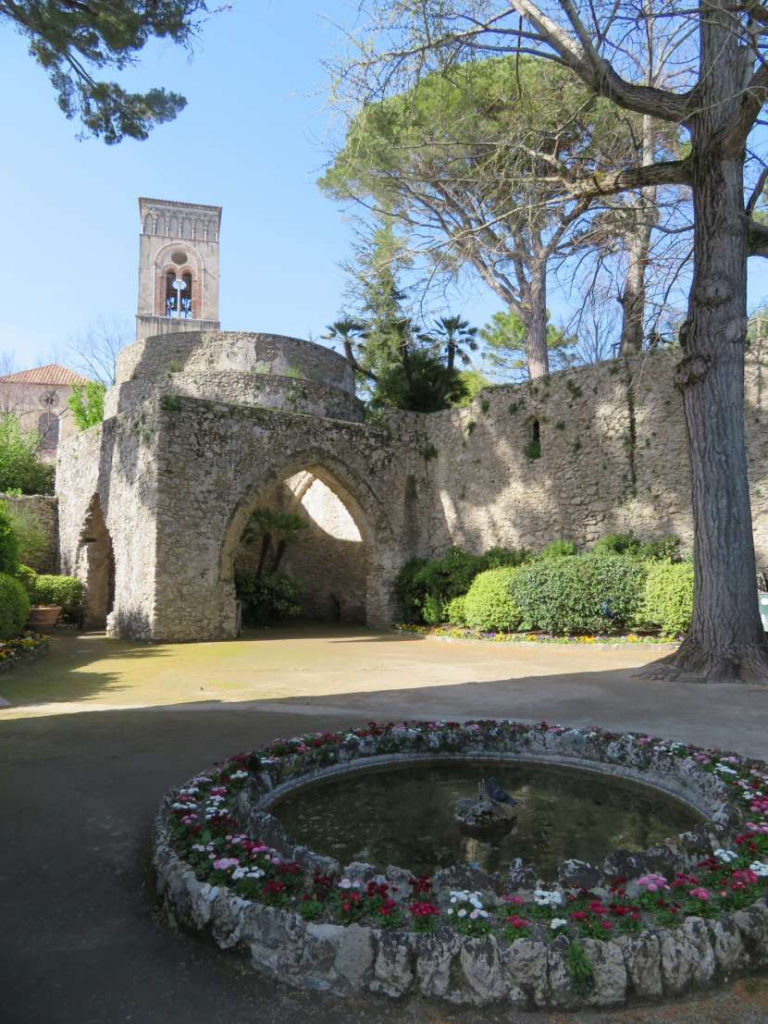
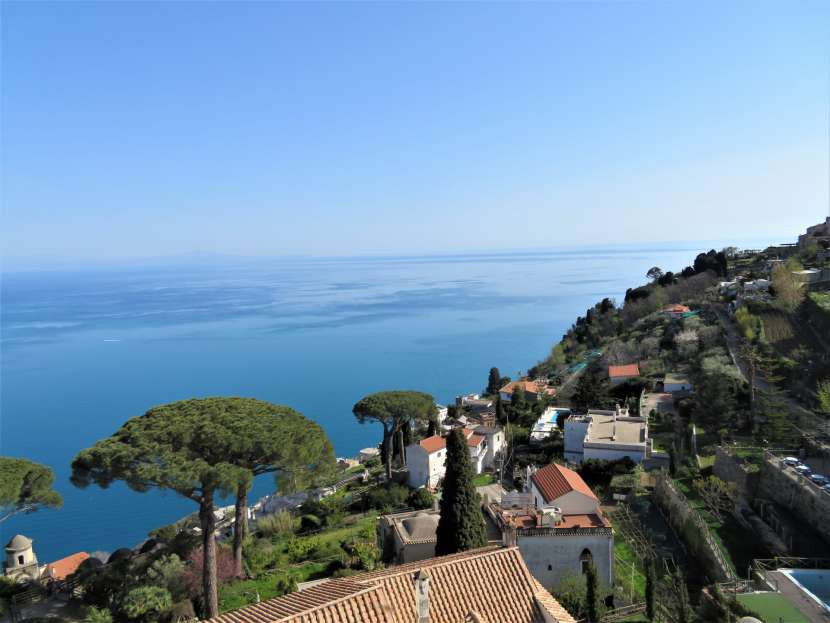
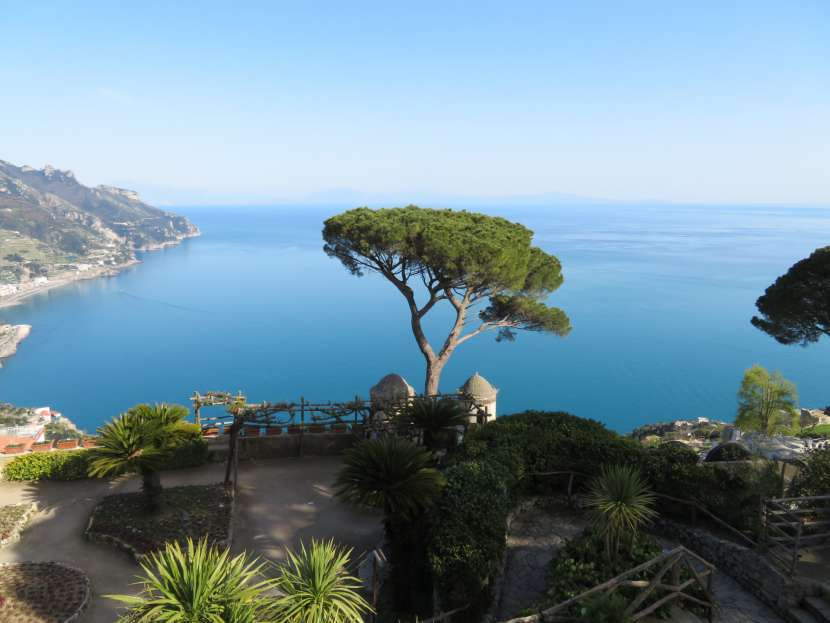
Villa Rufolo and the views from its garden
We took a different route back to Sorrento – through road SS145, which climbs above Ravello and then descends back towards the coast, while providing spectacular views of the Gulf of Naples and Mount Vesuvius that rises above it.
At the evening we strolled in the ancient and beautiful center of Sorrento, especially the pedestrian street Via San Cesareo and its surroundings. We felt that we needed a break from pastas and pizzas, so had a light dinner at a delicious and trendy burger bar called N’hambu.
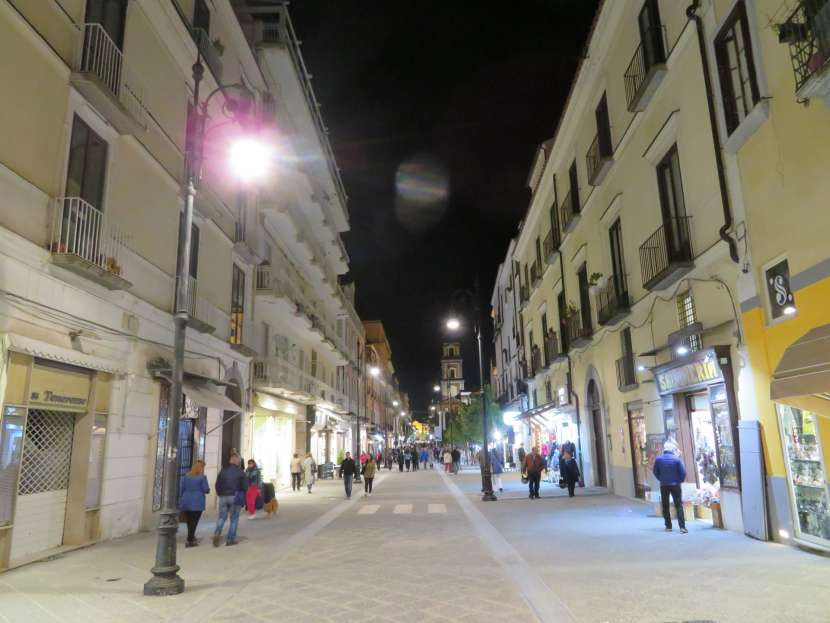
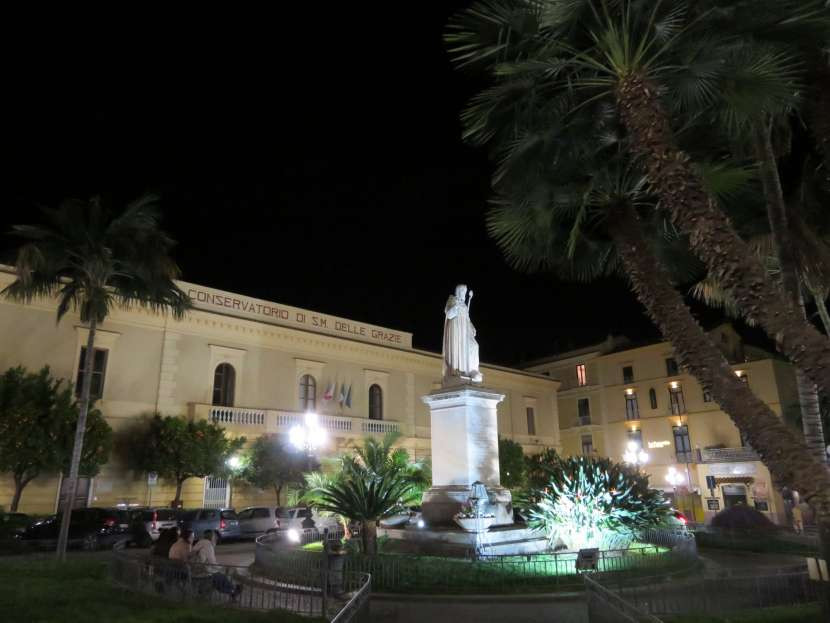

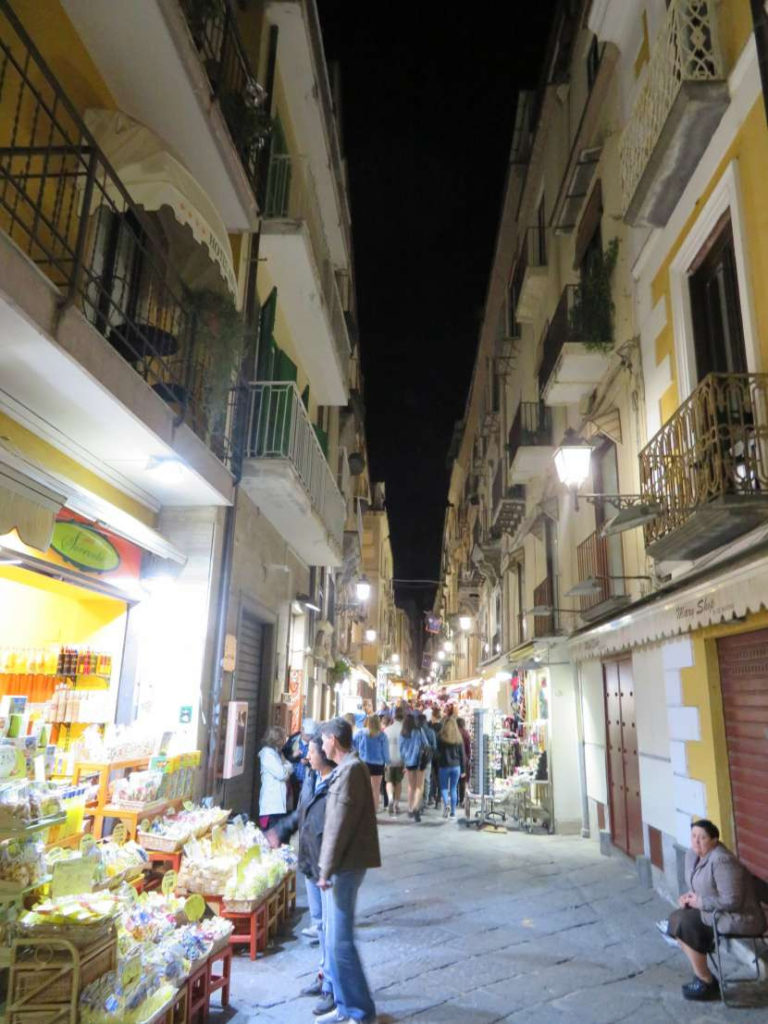
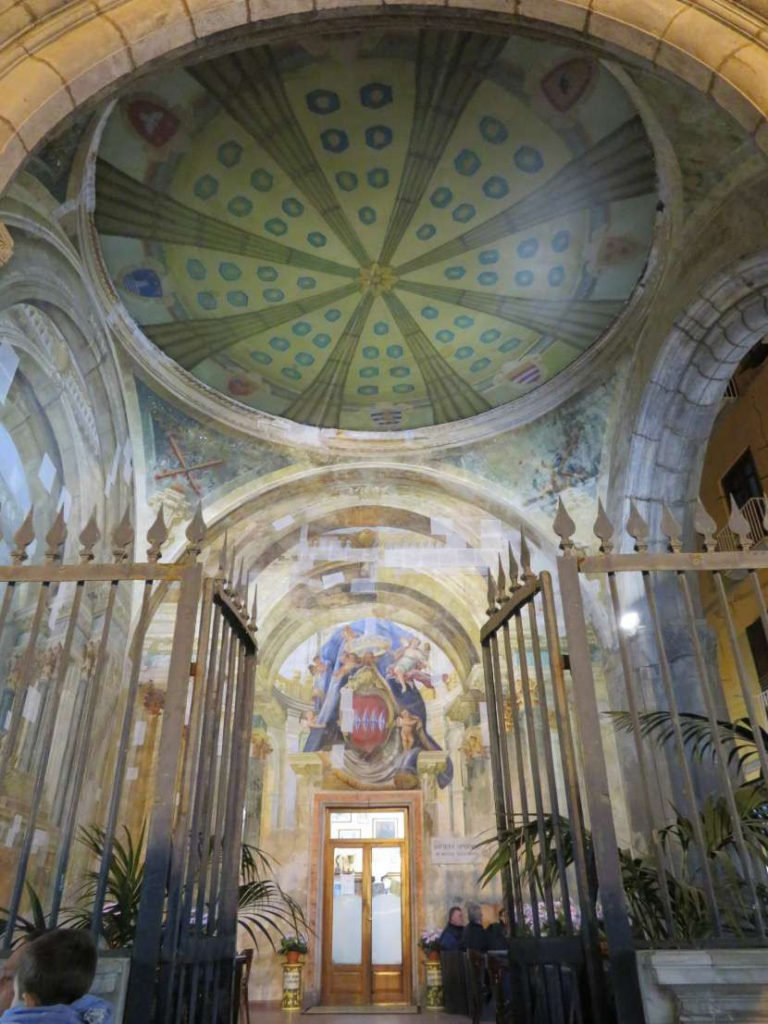
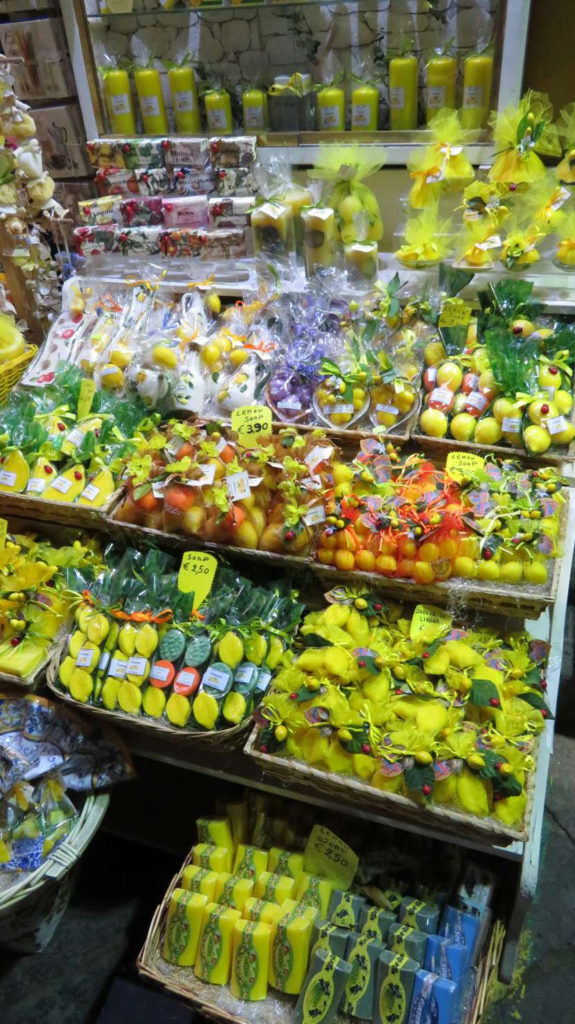
Sorrento at evening
Day 7
We left Sorrento in the morning and headed north towards Rome.
We planned to stop for a hike to the summit of Mount Vesuvius, but unfortunately the weather was cloudy, and the mountain peak was completely covered with clouds. Instead we stopped at Pompeii and had a quick two and half hours’ tour in the extraordinary site, visiting the main points of interest such as the amphitheater, the theater complex, the main bathhouse, the forum and some of the residential houses. We visited Pompeii before, but it is always fascinating getting back to this must-see destination – even if you are not an enthusiastic history and archeology fan.
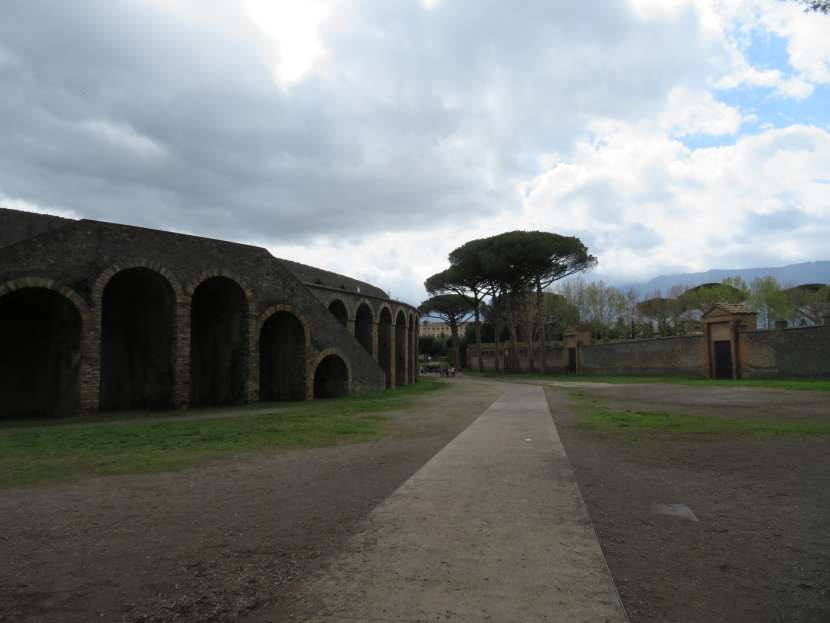
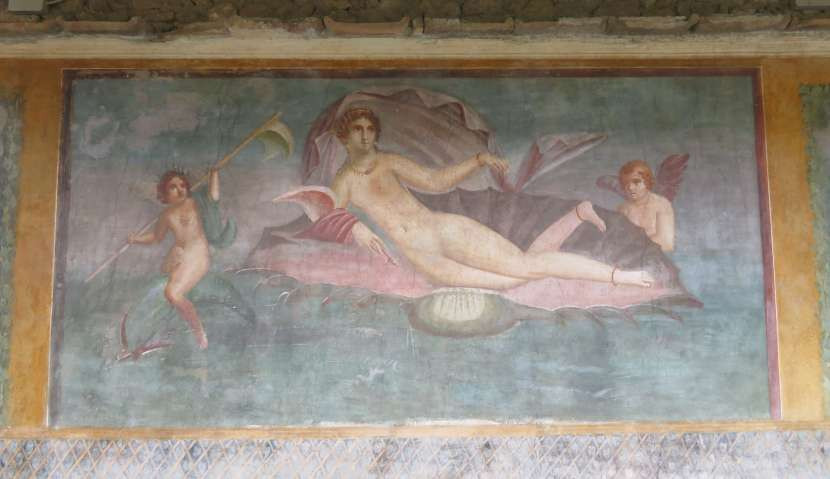

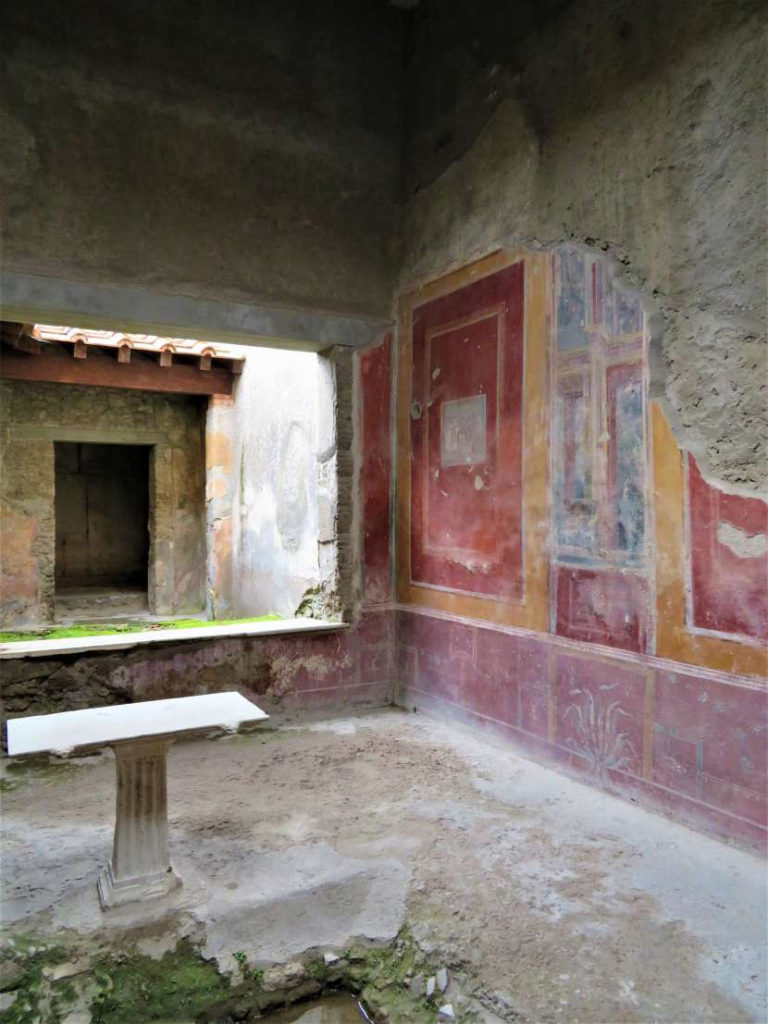
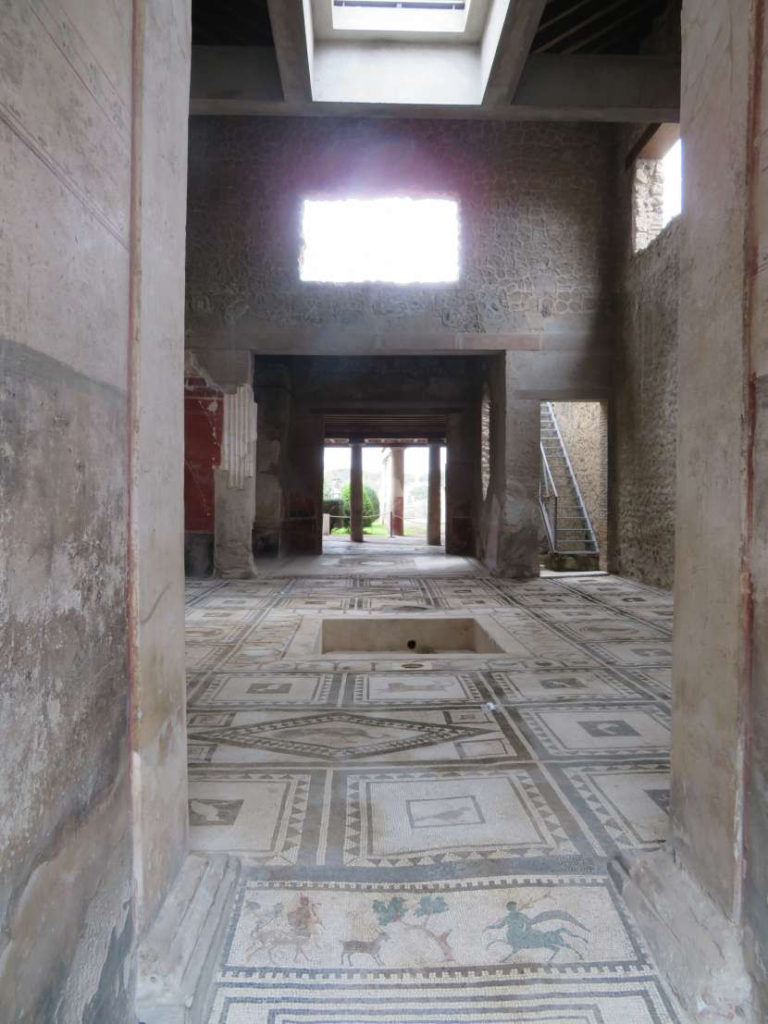
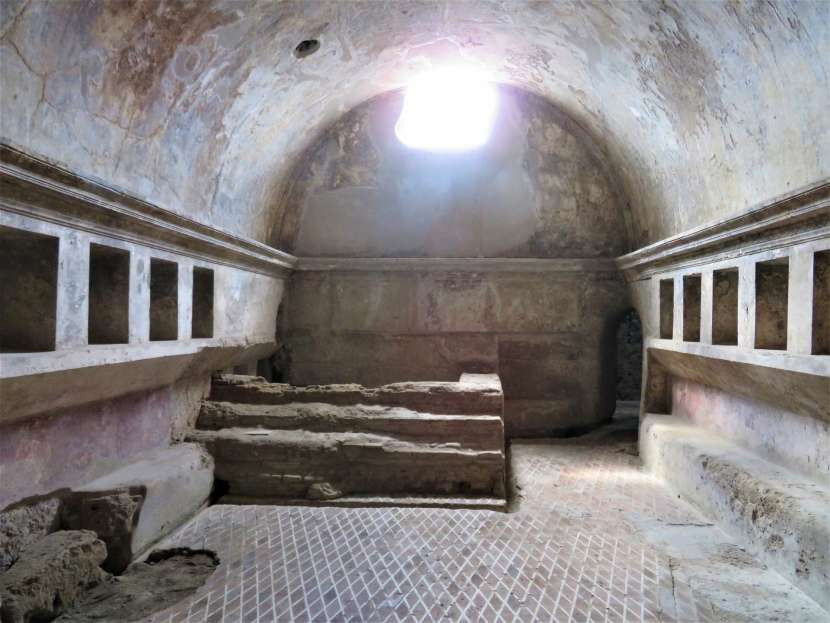
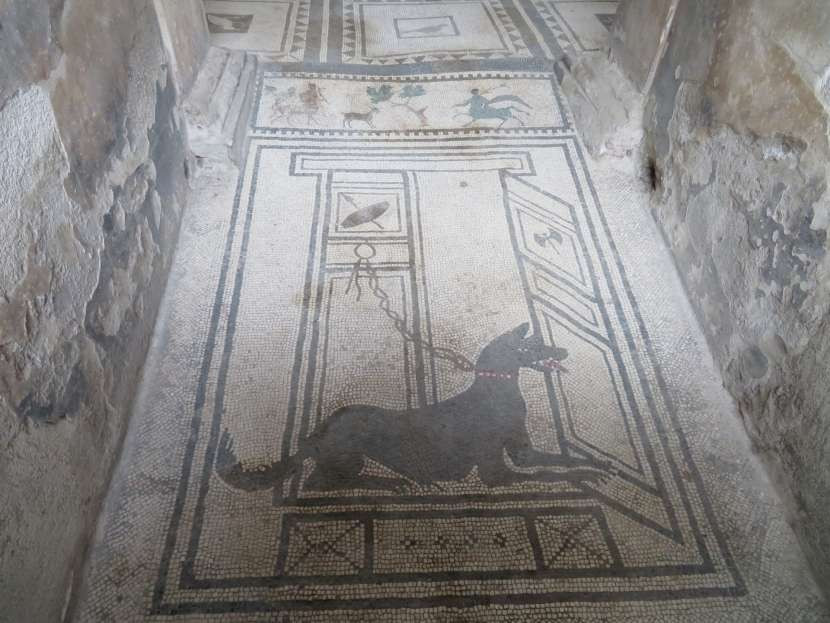
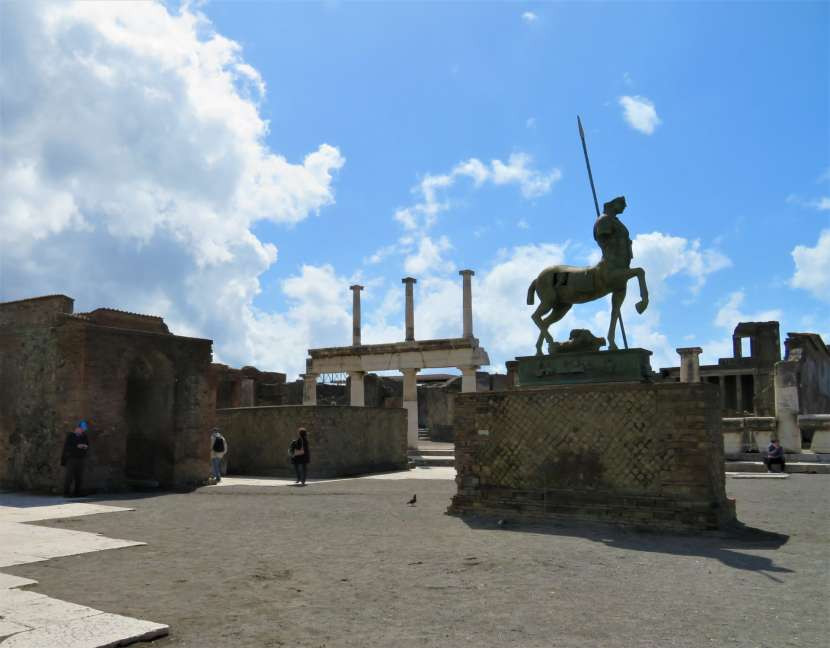

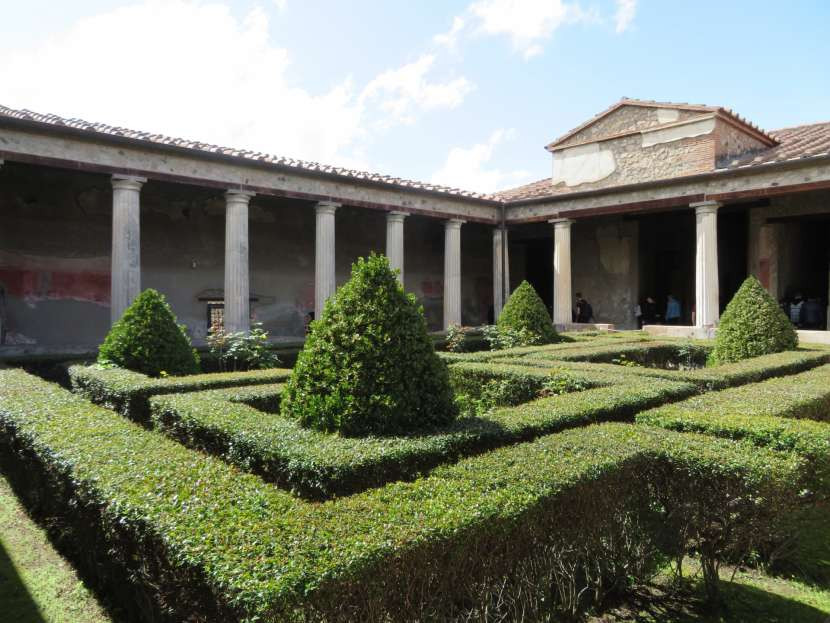
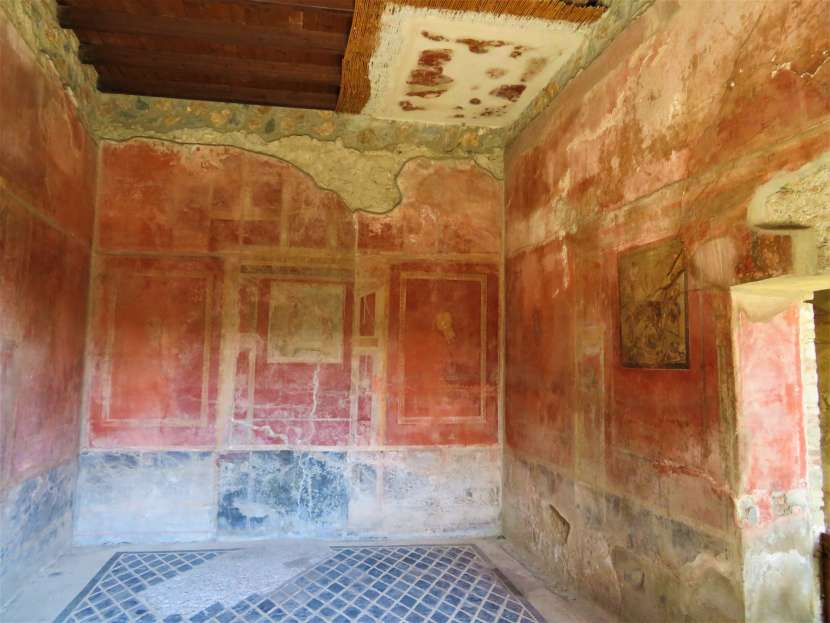
Pompeii – the city that froze in time
You can enter the Pompeii archeological site, which is quite large, from several directions. We parked our cars in one of the many available paid parking lots and used the amphitheater gate.
After visiting the antiquities, we had a quick lunch at one of the nearby restaurants and continued our journey towards Rome. We decided that our trip to Italy cannot be complete without a visit, even a very brief one, to the eternal city.
It is obviously not a good idea to travel in Rome, like any other major city, by car. Furthermore, the city center itself is closed for non-local cars during the day. Therefore, once we arrived, we parked our cars in the large Parcheggio Saba parking lot, which is close to Villa Borghese. The pedestrian exit from the parking lot leads straight to Piazza di Spagna, next to the Spanish Steps, but there is a long tunnel and some escalators you need to walk first.
We wandered around in the beautiful center of Rome and visited, naturally, Fontana di Trevi which was full as ever with excited tourists. We had one last dinner at a great restaurant called Spaghetteria l’Archetto which specializes, as its name suggests, in many different types of spaghetti and pasta – an excellent way to conclude our trip.
Spaghetteria l’Archetto (Facebook page)
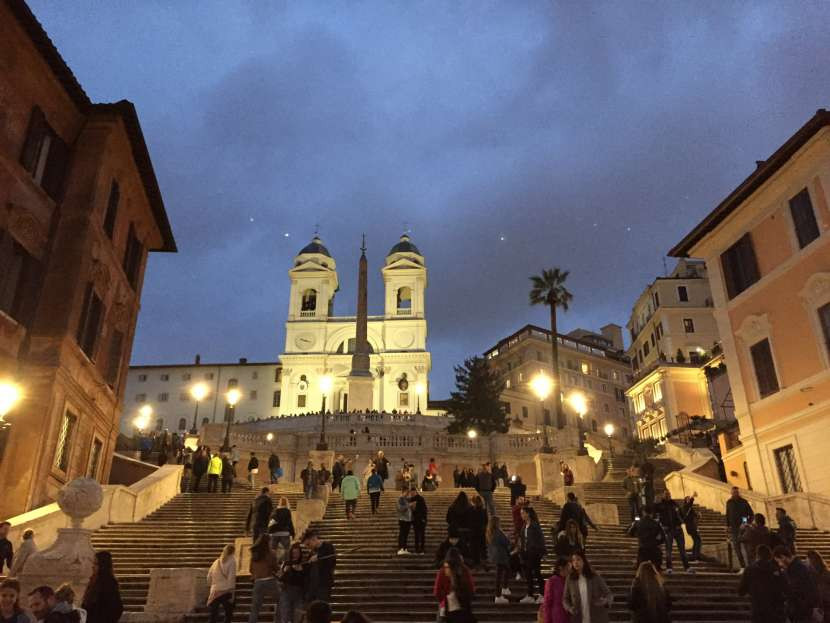
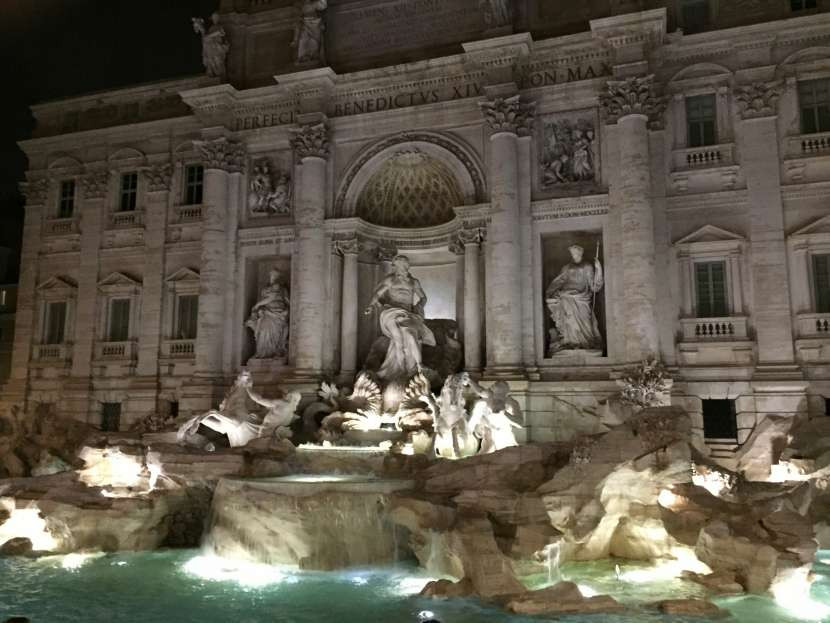
Rome at evening
We returned to our cars and drove to the hotel we booked for the last night – hotel Cristoforo Colombo, conveniently located in the south of Rome, 20-minutes’ drive from the airport. The cost for a large 4-persons room, including a basic breakfast, was 208€ per night.
Hotel Cristoforo Colombo website
Day 8
We woke up early, drove to the airport, returned the rental cars and boarded our flight back home.
Flight
There are obviously many airlines flying to Rome and Italy, depending on where you are coming from. Costs vary and depend on multiple factors, such as the season, time of booking, etc.
We flew from Tel-Aviv with Ryanair, the cost was around 350€ per person (including 1 piece of luggage and seat allocation).
Car Rental
We rented two cars for 7 passengers each from Hertz. One of the vehicles we got was Ford Galaxy, the other was upgraded to a 9-passengers van – a bit more cumbersome for driving but very spacious and comfortable. The cost was around 580€ for 7 days, including extended insurance.
If you are planning a similar trip and have any questions, you are more than welcomed to contact me at maaqsa@hotmail.com.
Have a great trip !
Amir.

